A.I allows for intellectual exploration, academic dishonesty
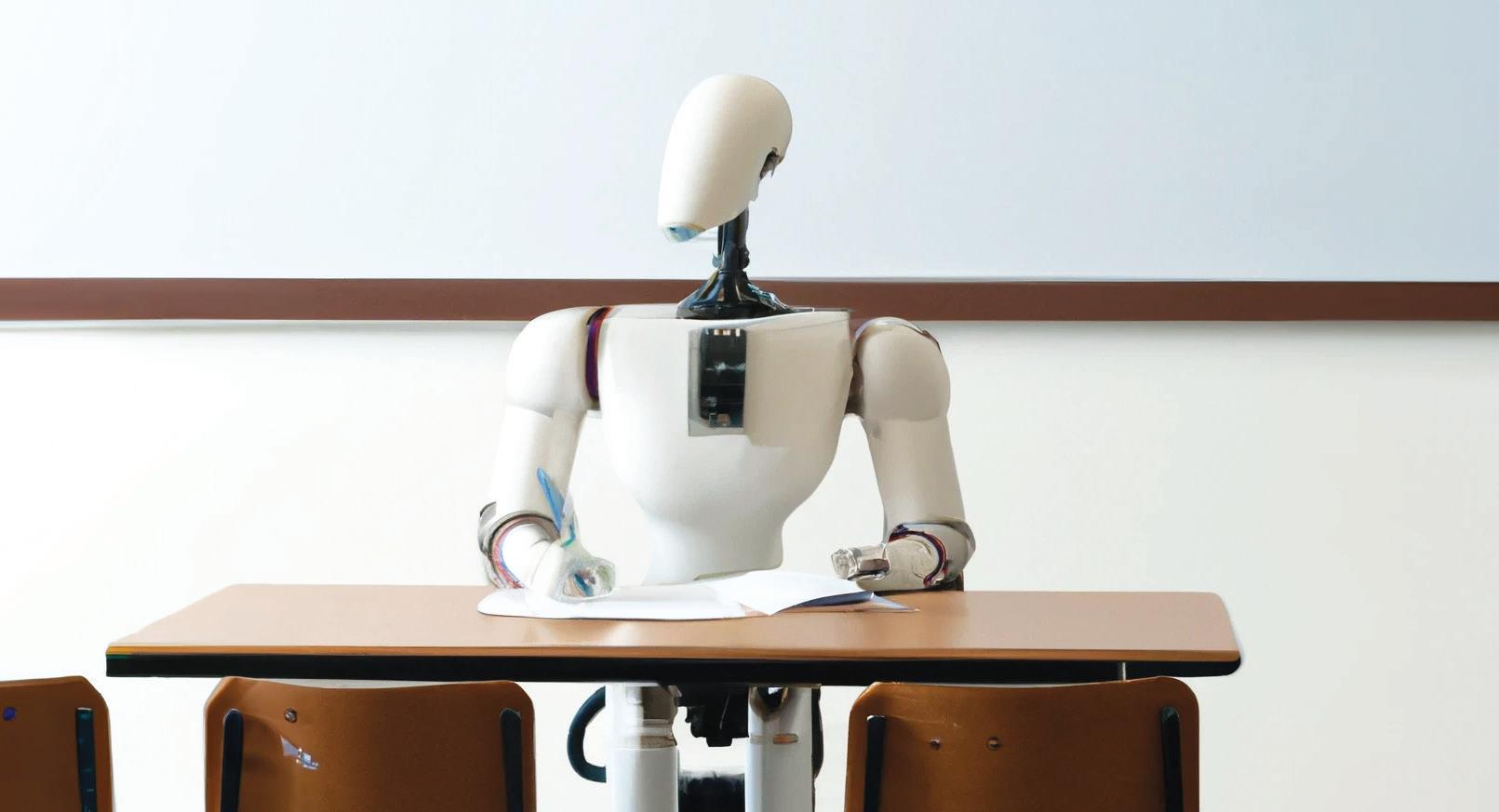 BY SAMHITA KUMAR & EESHA DHAWAN
BY SAMHITA KUMAR & EESHA DHAWAN
As the world becomes increasingly digital, the line between human and machine communication becomes blurred. Enter ChatGPT, a cutting-edge language model that can understand and respond to natural language with uncanny accuracy.
The previous paragraph — written by ChatGPT — only begins to describe the language capabilities of OpenAI’s newest
creation.
ChatGPT describes itself as “a large language model” that is “trained using a massive amount of data to generate human-like text.”


Launched on Nov. 30, 2022, the service has become well-known for its range of possible outputs — the AI can produce language translation, text summarization, debugging and question answering, ChatGPT said.
The phenomenon extends to the Country Day campus. In a Jan. 10 Octagon poll of
the high school, 39 of 54 respondents said they have used the service.
Those uses ranged from an exploration of the AI’s potential to AI-assisted cheating on academic assignments.
Exploring ChatGPT
Sophomore Ryan Pirie has used ChatGPT to help with his programming projects.
“I was programming an AI that follows a similar structure as ChatGPT, so I was testing to see what they had accomplished and
what they had done,” Pirie said.
It has helped him uncover some of the limitations of AI.
“It is designed to make answers seem correct. It isn’t really trying to be right, it’s trying to look correct,” he said.
It’s especially a problem when it comes to using ChatGPT as a source of information.
“It’s pulling from the internet, and the internet isn’t always right,” Pirie said.

Procrastination deters students from getting work done
BY LAUREN LU
Students on campus buzzed with life and energy at the start of the 21-22 school year, but then-sophomore Grace Zhao could not smile with them.
Instead, she was consumed with anxiety about her first Human Geography assignment, which, despite its simplicity, she could not bring herself to start.
For years, Zhao, now a junior has been a procrastinator. Beginning in middle school, the ease of the material in her classes allowed Zhao to glide by with minimal effort. As a result, her procrastination developed gradually over time.
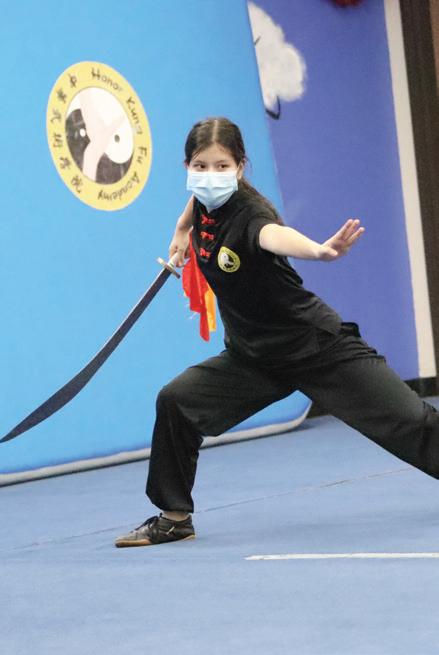
“When you’re young and you procrastinate, there are no consequences,” Zhao said.
“I remember I would get home and watch YouTube until 9 p.m. And then, in the last half hour, really last minute, I would just rush through my work and go to bed.”
Despite its negative consequences, procrastination is pervasive in student culture at Country Day.
Pamela Peters, the social and emotional counselor for middle and high school, identified several causes of procrastination, such as fear of failure, distractions, and a tendency to avoid stress.
However, the root of procrastination, fear, can be attributed to “monkey mind,” a term that has been used for years, Peters said.
“When monkeys swing from trees, they make a loud, crazy screeching noise, and they compare that to the noise we sometimes hear
CAMPUSCORNER
Winter Formal
On Feb 11, 2023, high school students will be able to attend the WInter Formal for the first time since the COVID-19 pandemic. The Winter Formal sits as a segue between Homecoming and Prom, as students are urged to dress formally to fit in with the masquerade theme.
Blind-Dating Game
On Valentine’s day, students will gather in the high school quad to enjoy the return of the blind-dating game. There, 10 students will compete to win the everlasting affection of a bachelor and a bachelorette through a series of questions to see who is meant to be.
in our heads, the noise full of worry, doubt and what-ifs,” Peters said.
It is Peters’ task to help students become aware of their needs and overcome their fears.
Although many may not realize it, fear is linked to the monkey mind, which everyone has.
“What really gets in our way are our thoughts, beliefs and opinions,” Peters said. “Regardless of the facts, whatever you believe is true is really true for you, and it can really get in the way of making your dreams a reality.”
Once the belief of not being enough or not having what it takes sets in, so does the urge to avoid stress and difficult tasks.
That’s when hormones like adrenaline are
released in the brain and the response is an intense dread and fear of failure and incompetence, Peters said.
“The fear gives you two choices — fight or flight — but either way, the response creates more anxiety, depression and shame, and it can even lead to physical illness,” Peters said.
Zhao has experienced the tremendous toll that procrastination has taken on her mental health.
“In middle school, I would pass most things without studying, so I didn’t know how to study or have any skills when I needed them. It started getting really stressful,” Zhao said.
Zhao said her willpower to accomplish goals and complete assignments was severely PROCRASTINATION page 3 >>
BY ADAM AKINS
VOL.46 NO.5 • Sacramento Country Day School • 2636 Latham Drive, Sacramento, CA •www.scdsoctagon.com • Februrary 8, 2023 Non-Profit Organization U.S. POSTAGE PAID Sacramento, CA Permit No. 1668 OCTAGON @scdsoctagon THE
CHAT GPTAKEOVER DALL E, an A.I art generator, created this image using the prompt, “Show a robot in a class writing on a piece of paper.”
A.I page 6 >>
FEATURE
Country Day students compete in wushu Learn how Kai and Chloé Hirahara have taken the steps to master an ancient martial art. (PAGE 4)
PHOTO
Cavs win Golden 1, Homecoming games
PRINT EDITORS-IN-CHIEF
Simone DeBerry
Garman Xu
ONLINE EDITORS-IN-CHIEF
Adam Akins
Samhita Kumar
NEWS EDITOR
Ishaan Sekhon
FEATURE EDITOR

Ava Eberhart
SPORTS EDITOR
Jacob Chand
A&E/OPINION EDITOR
William Holz
PHOTO EDITORS
Adam Akins
PAGE EDITORS
Andrew Burr
Jacob Chand
Emily Cook
Simone DeBerry
Ava Eberhart
Saheb Gulati
William Holz
Lauren Lu
Ishaan Sekhon
Garman Xu Garrett Xu
BUSINESS STAFF
William Holz, manager
Aaryan Gandhi
Saheb Gulati, assistant Garrett Xu
SOCIAL MEDIA STAFF
Samhita Kumar, editor
Ava Eberhart, assistant
Lauren Lu
REPORTERS
Rehan Afzal
Siri Atluri
Eesha Dhawan
Aaryan Gandhi
Daniel Holz
Irene Jung
Sophia Monasa
Anisha Mondal
Anika Nadgauda
Zema Nasirov Ryan Xu
PHOTOGRAPHERS
Rehan Afzal
Adam Akins
Simone DeBerry
Anika Nadgauda
Zema Nasirov
MULTIMEDIA STAFF

Garman Xu, editor
Jacob Chand
Simone DeBerry
Ava Eberhart
Irene Jung Ryan Xu
GRAPHIC ARTISTS
Brynne Barnard-Bahn
Lauren Lu
ADVISER
Bonnie Stewart
The Octagon is the student-run newspaper of Sacramento Country Day high school. The print edition is published eight times a year, and the website is updated daily. The Octagon is committed to unbiased and comprehensive reporting, serving as a source of reliable information for SCDS students and the school community. The Octagon will publish all timely and relevant news deemed appropriate by the editors-in-chief and adviser. We seek to highlight high-school-related events and spotlight the voices of those with a story to share. Further policies can be found on our website or by scanning the QR code below.
BY SIRI ATLURI
Flashing lights and cheers from the crowd welcomed Country Day’s Cavaliers to the Golden One Center as the basketball players prepared for an exhibition match in the home of the Sacramento Kings on Jan. 12.
Two weeks later, the Cavs were welcomed yet again with the screams of Country Day students, this time for their Jan. 27 homecoming games.
Golden 1 Experience
The boys and girls varsity basketball teams both played Valley Christian High School’s Lions for the match at the Golden One Center.
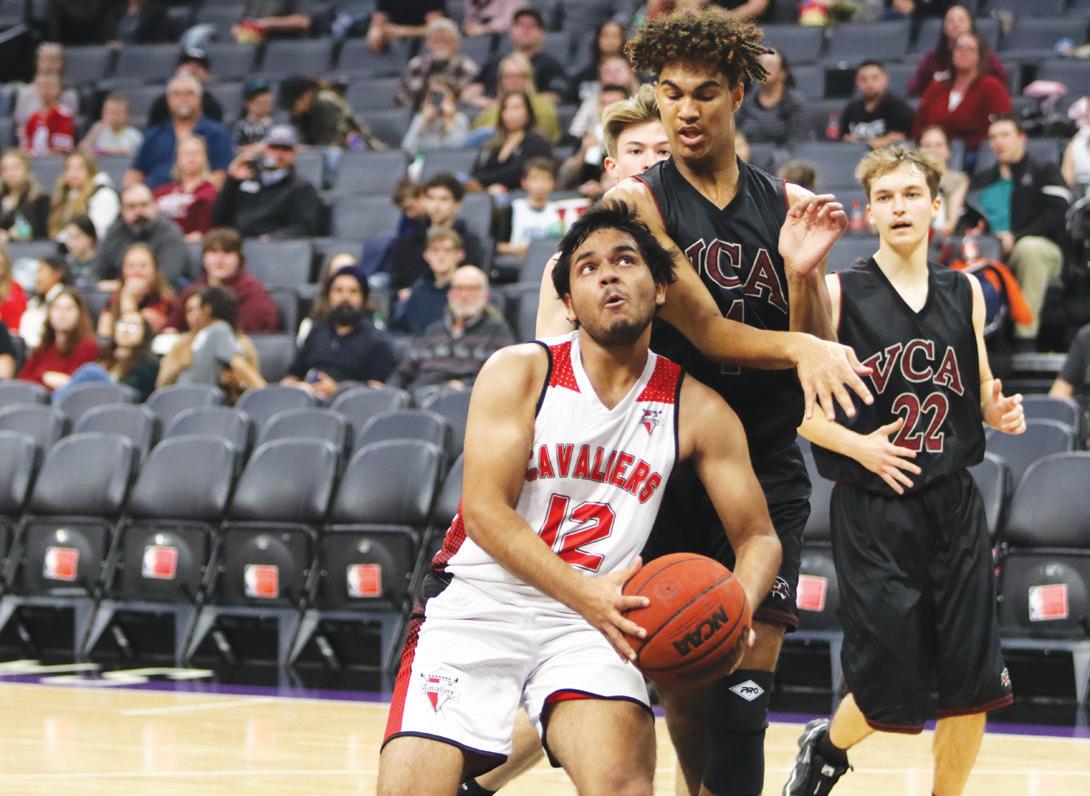
The boys secured a win with a one-point lead and a final score of 59-58, while the girls lost their game, 57-34.
Standout players for the boys’ match included three seniors: power forward Tonye Jack, and point guards Jonah David and RJ Vargo. Junior center Derek Taylor stood out during the game as well.
“Just getting the experience to be able to play at Golden One was great. It’s kind of a dream for just about everybody who’s ever played basketball, and it’s the best stadium in actually all of the NBA,” Taylor said.
“So, the fact that we, as a bunch of high schoolers, got to play at it was quite exhilarating.”
The stadium’s environment, coupled with the outcome of the match, gave the team a much-needed boost of confidence — especially after its previous loss at its home game against Sacramento Adventist High School.
“I think it showed that we can compete against any team in the league,” Jack said. “Being able to play in that big of an area was such an environment — it was a big team morale boost, and it was very fun.”
Jack and Taylor initially found the court daunting, but quickly found their footing.
“I expected the court to be a
lot bigger,” Jack said. “I thought I would get a lot more tired running around there. But, I didn’t feel so tired; I felt pretty natural.”
That night, Valley Christian fielded a large varsity team and rapidly rotated players.
Country Day’s team was much smaller, especially missing senior center Jacob Chand due to a sprained ankle.
“We knew they were just going to run us,” David said.
Still, Country Day gained a small lead over Valley Christian because of quality distribution from Vargo, who paired well with sophomore center Henry Wilson.
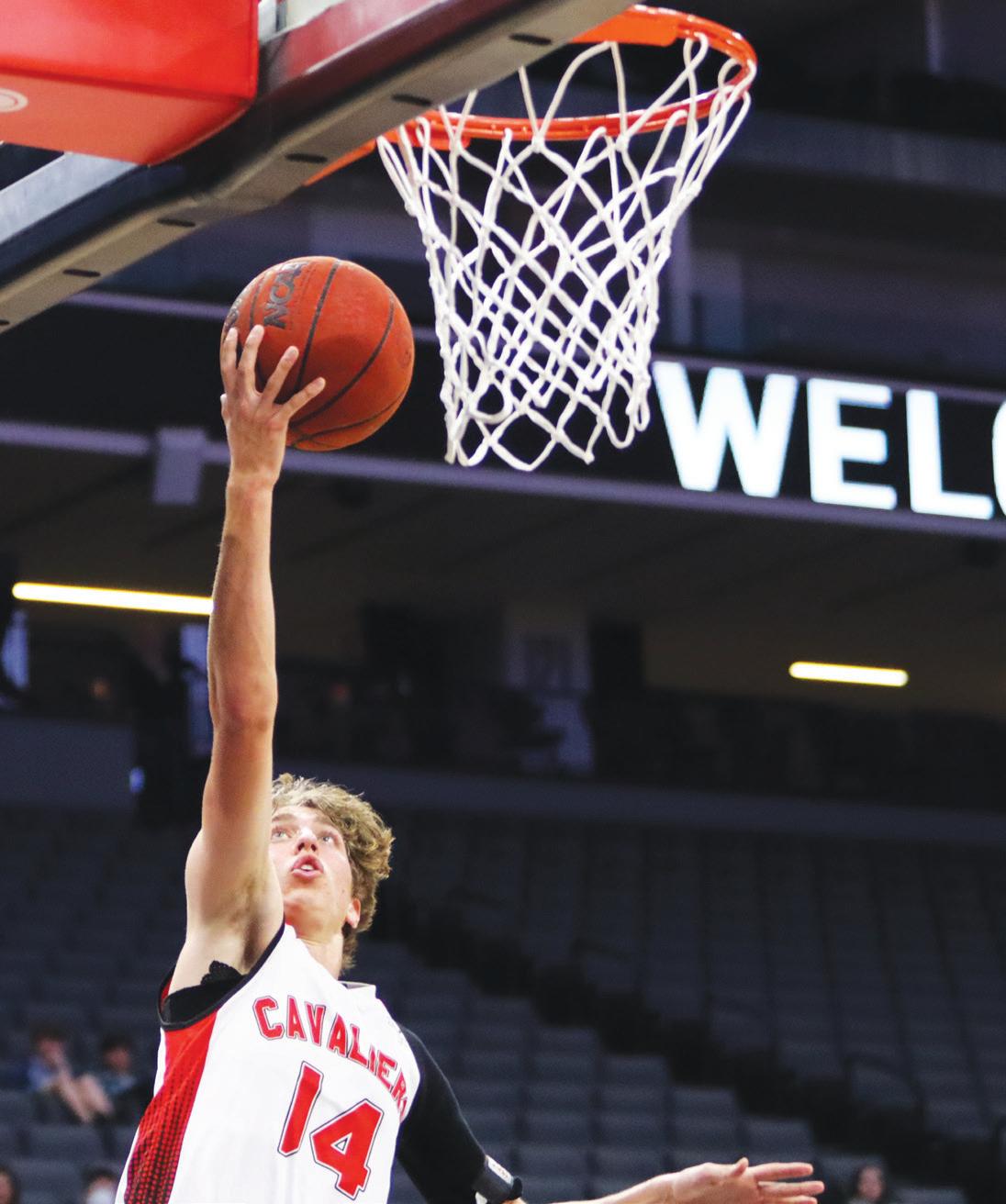
The fourth quarter shook the Cavs’ control of the game. Taylor fouled out, requiring senior power forward Ryan Paul to step up and defend Valley Christian’s threats in the paint.
To increase the pressure, both Vargo and Wilson had to play through injury.
Vargo aggravated a pre-existing injury to his shoulder, and Wilson rolled his ankle while taking a jump shot.
“We did miss a ton of layups — like 20 of them — which is around 40 points. And, we won by one. So, it definitely could have changed the game by a significant margin,” Taylor said. Taylor reports that although the team made bad decisions, overall it went well.
“That whole last five minutes felt like forever,” Jack said. “But eventually, we got there.”
The match was suspenseful, with Valley Christian leading much of the game. Near the end, however, the Cavs whittled down the big lead to 2 points, and Jonah David hit a 3-pointer from the left corner, giving the Cavs’ a single-point lead.
With the win, the Cavs advanced their record to 5-7-0 on the season.
Although the girls faced a loss of 57-34, freshman point guard Ella Martinelli was nevertheless proud of the team’s significant improvement compared to last year’s season.
The girls team struggled against the height and skill
that Valley Christian brought, but the defensive duo of senior center Brynne Barnard-Bahn and junior center Rachel Pirie challenged effectively, and Martinelli scored eight 3-pointers.

“We were really trying to have fun, because we lost by like 90 last year. I feel like it was a really good bonding experience for us,” Martinelli said. “It was a big staple in all of our basketball careers.”
Homecoming Game
Country Day’s varsity boys and girls basketball teams both beat the Cristo Rey Saints during their homecoming games on Jan. 27. The boys won 62-28, while the girls won by one point, 27-26.
“It was nostalgic playing Cristo Rey for the last time,” senior Barnard-Bahn said.
“I feel like I’ve been at odds with them for a while. I’ve jammed my fingers against them twice and chipped my tooth. Every time I played
against them I got an injury. But this time, I came out unscathed.”
David said the other team played aggressively.
“Tonye really kept his composure, because some players were pushing hard,” David said.
The homecoming game had Country Day students filling the seats to support the Cavs.
“There’s a bunch more people watching you,” Barnard-Bahn said. “So, there’s a lot more pressure. If you win, then everyone’s proud of you. If the other team had stolen that, we would have been kicking ourselves after.”
Overall, the Cavs’ hard work paid off.
“I think we did a lot of good team play, and we’re making our shots,” David said. “I’m just happy that I came in at 6 o’clock today and hit a bunch of threes.”
As the season comes to a close, the Cavs will play their last home game on Senior Night against Faith Christian’s Lions on Feb. 9 at 7:30 p.m.
02 NEWS FEBRUARY 8, 2023 • THE OCTAGON
STAFF
RIM RUNS [Clockwise] Senior Ryan Paul shields the ball from a defender on a layup; Senior RJ Vargo stretches out his hand to score; Junior Imani Cochran attacks the rim. PHOTOS BY ADAM AKINS AND ZEMA NASIROV
Weather Updates: The calm after the storm
BY JACOB CHAND
Raining in the New Year, the Sacramento region and much of California were hit by an atmospheric river.
This phenomena, according to Deborah Williams of the National Weather Service, “acts as a continuous cycle of moisture with a comparison to a conveyor belt of rain.”
Country Day sophomore Priya Chand got caught on that belt on Dec. 31.
Chand and her friend hydroplaned on Fair Oaks Boulevard on their way to ring in the New Year with some friends. Just 35 minutes away from home, they found themselves in the middle of one of the deadliest waves of fatal weather trends.
At approximately 8 p.m, Chand remembers the sequence that almost cost her her life.
“You basically couldn’t see five feet in front of you — the rain was like a barrier,” she said. “Lights were out and everywhere you looked trees were dropping like flies. Then, out of nowhere, a tree just appeared causing us to run off the road.”
Yet, her night was far from over. After calling her dad, towing companies were so backed up that the car couldn’t be moved until the next day. Hence, she waited a long hour for her dad to pick her up.
“The whole time we were sitting, anxious about a tree just falling and hitting our car,” she said.
However, Chand’s seemingly unusual and life-threatening experience proved to be common among her Country Day peers. Other Country Day students and faculty are still recovering from the tremendous
repercussions of that tropical storm.
For junior Annalucia King, storm damage still hangs over her household weeks after its initial occurrence.
In total, King estimated there was more than $10,000 worth of damages done to her property at her home in Land Park.
The biggest hit came when a large oak tree limb smashed onto the car in her driveway, crushing the car’s windshield, hood and roof, destroying it beyond repair.


Tree limbs also damaged the roofing on her garage and the gym area of the house.
The storm kept going, and King watched as her fencing was ripped in half.
“It was really scary seeing the fence being whipped back and forth,” she said. “That was really the point where I knew the storm was getting bad.”
Less than five minutes away, Director of College Counseling Alicia Perla’s Land Park home faced a different hardship as the storms ravaged her neighborhood.
For four days, Perla’s home sat in darkness as power outages circulating throughout Sacramento affected every aspect of her daily life.
Practically speaking, Perla detailed her life halting, as her access to hot water, a working refrigerator, a heater, her stove and Wi-Fi were all gone.
Consequently early January for Perla and her two daughters sophomore Cecilia and senior Simone DeBerry consisted of navigating through tree-strewn roads and charging their phones in the car to have enough battery to find out updates on the SMUD power grid.
During this period, Perla and her two daughters stayed at a friend’s house, waiting to return to their normal lives.
However, the dread that hit Sacramento County, fortunately stayed far away from Country Day’s campus, as students were able to return to school immediately.
Head of Maintenance Jay Holman said, damages to the school were minimal.
“We were really lucky, he said.” “Apart from some small limbs, a broken roof tile in the lower school and some other cleanup our crew did around here, we weren’t hit that hard.”
The biggest surprise to Holman was the school’s ability to maintain power.
“I know that schools in the surrounding area had to take the day off because they really had nothing, but we really hit a strike of luck that our power still stayed on,” he said.
Even though Country Day held up against the storm, Head of High School Brooke Wells and other faculty members across the school were prepared for the worst.
“We would have continued with classes asynchronously through Zoom,” he said. “We understood there would also be students who didn’t have access to the internet due to power shortages, so we were ready to be flexible for the sake of our students.”
Wells added that there is no school policy regarding what to do in the event of extensive storm damage, however, the school has shut down in the past for similar situations.
Nevertheless, amidst the chaos of the following weeks, Wells and others fear that this could be a common trend our region faces for the upcoming years.
This fear can subsequently be diminished through easy steps, Williams said.
Mindset: Tackling procrastination
(continued from page 1)
undermined, and that stemmed from building her study habits around procrastination.
The anxiety built up to the point where she was unable to bring herself to start her homework.
For Zhao, however, stopping the procrastination proved incredibly difficult.
“I always recognized that it was a problem, but I didn’t have the maturity or willpower to do anything about it,” Zhao said. “It’s tough to have that level of executive function at a young age.”
Having the self-awareness to recognize that procrastinating was detrimental to her mental health and academic performance was the first step to stopping for Zhao.
Removing distractions from her work environment, such as her phone, has helped her remain focused.
Peters said there is a connection between procrastination, mental illness and health, emphasizing that most negative thoughts are produced by the monkey mind.
According to Peters, the more stress and trauma that one has experienced, especially in childhood, the more difficult it is to believe in oneself.
However, it is not impossible.
“A belief is only a thought that you keep telling yourself over and over,” Peters said. “By questioning these thoughts, you can
start to release some of your anxiety.”
The imagination is one of the strongest gifts that is used infrequently, Peters said. So, she encourages and recommends writing down affirmations and journaling to think positively, improve self-confidence and relieve stress.
“It’s a process and it takes practice, but it’s not hard,” Peters said. “Close your eyes and imagine yourself doing well, and no matter what your monkey mind says, keep doing it.”
Although developing an awareness of monkey mind covers the mental aspect of procrastination, external factors still remain. Oftentimes, they enable the habit to persist.
To combat this, freshman Ava Dunham clears her workspace of distractions to prevent procrastination.
Other methods that Dunham uses are mapping out projects, creating timelines and self-imposing deadlines; however, they are not always effective.

For example, “something will come up, like an assignment from another class that needs to take priority,” Dunham said.
“So, I end up getting behind and becoming a big procrastinating mess again.”
Dunham also struggles to center herself when completing unappealing work.
“I will find a reason to leave whatever I’m doing, and it never works out well,” Dunham said.
“If I think that I could excel at something, I am interested in it, but if I’m not interested, I don’t feel motivated enough to want to do well, so I end up finding reasons to get myself distracted.”
To eliminate procrastination, Peters offers advice on how to improve external factors.
1. Separate each large assignment into smaller more manageable tasks and work in smaller time frames with a number of breaks.
2. Reward yourself after completing a task. Instead of treating finishing work as a thankless expectation, a reward triggers positive hormones, such as dopamine, to be released in the brain.
3. Create a study or work environment void of distractions.
4. Remove phones and other devices from the area, setting them on “Do Not Disturb.”
5. Consider going to a library or coffee shop to eliminate distractions at home.
6. Find an accountability partner, someone who can both support you and hold you accountable.
Although implementing such advice is hard, continued practice of these tips will help build effective study habits.
This is specially important for those aiming to put an end to their negative habit of procrastination with the beginning of the new semester.
For starters, essentials like food, water and medical supplies, flashlights, batteries,a backup generator if accessible and documents important to you like driver’s licenses or passports should be kept in a safe and accessible place ready to go. Once prepared, ensure your car is filled with gas, access to potable water, have an established emergency plan with you and your family and continue to watch news alerts about storms in your area.
NEWS 03 FEBRUARY 8, 2023 • THE OCTAGON
FISTS OF FURY FISTS OF FURY
Inside the Honor Kung Fu Academy, a small wushu school located on Florin Road, freshman Kai Hirahara performs a leaping butterfly kick, his chain whip slicing through the air below him with an electric buzz. Junior Chloé Hirahara is up next. Her straight sword produces a metallic clang as she snaps into a one-legged stance.
Kai and Chloé have been practicing wushu, a modernization of traditional Chinese Kung Fu, since 2017.
Before taking up wushu, Kai and Chloé trained in hunter and jumper horseback riding. But when Kai’s horse bucked him off and stepped on his arm during riding practice, their father, an orthopedic surgeon, was starting to get worried about their safety.
“The problem was the horses were being a little bit naughty, and they started doing some bucking and I noticed that my kids were falling off a little bit too easily,” Dr. Alan Hirahara said. “At some point I said, let’s take a look at martial arts really fast because my dad did wing chun when he was young.”
When the Hiraharas were not able to find a good wushu teacher around, they stumbled upon the Honor Kung Fu Academy. After a trial lesson, they realized wushu was their solution for a safer and more athletic alternative to competitive horseback riding.
“Chloé was watching these guys doing these flips and Kai was watching these kids wielding swords,” Dr. Hirahara said, recalling the moment they entered the academy. “They both looked to me like, ‘we get to do that?’ So, admittedly, it was not really a hard sell.”
Dr. Hirahara also appreciated the instructors’ strong emphasis on basic exercises and stretches.
“The more I looked into it and started looking about competition wushu in China, these guys were on par with some of the best. I was blown away that a couple of guys in South Sacramento were this good.”
“Those guys” turned out to be Sifu Tan Chongfang, the school’s founder and owner, who had toured internationally and performed wushu at the China Central Television New Year’s Gala and 2008 Beijing Olympics.
Although teaching high-level wushu is a priority for Chongfang, his coaching philosophy is to first get his students into the right state of mind and attitude to make
practice more effective.
“Even before learning wushu, it is important to learn the traditional Chinese values of community and respect for others,” he said. “Respect your teachers, respect your parents and always be your best. Never say ‘I can’t’ and use kung fu only for good; these five phrases represent our school’s mission to build self-confidence and discipline.”
The transition from horseback riding to kung fu was not easy for Chloé and Kai. Although the two had trained in horse riding and performed in competitions, they realized they needed to develop their physical capabilities and endurance further to perform even the most basic of kung fu movements.
“It took time and also just aging as well,” Chloé said. “When I was younger, I had no strength, no flexibility and no endurance.”
Chongfang helped them build those skills little by little, training jibengong, or essential techniques such as acrobatic rolls, and then later handpicking more advanced forms as they progressed.
Through his experience coaching students of all ages, he realized using a fun reward and punishment teaching structure helped both motivate his students and reinforce effective learning.
“According to the students’ performance, I slowly increase the pressure and difficulty in teaching their skillset,” Chongfang said.
“ I found this method really helps my students focus 100% of their attention on doing the task at hand and trying to improve.”
In addition to the physical challenges, Chloé and Kai also had to adapt to and overcome the mental challenges of performing kung fu. Unlike horse riding, the two had to get comfortable with using their own bodies and be able to execute their moves under pressure.
“When they first started, they did not have much self-confidence to perform their routines with pride,” Chongfang said. “The Kai and Chloé you see now are more comfortable with their own presence because of their experience built through many performances and competitions.”
After five years of training, Chloé and Kai now shift their focus away from the basics toward fine tuning and modifying their techniques to elevate their performance routines.
“Now that I’m not a beginner anymore and I’m more advanced, I don’t really care about the belt levels,” Kai said. “Coach
gives you a form to learn, and if you like it, you can expand on it, put in more acrobatics and change it.”
Kai studies a northern style of wushu which involves kicks, acrobatic movements and weaponry as well as sanda, a form of Chinese kickboxing. Chloé instead focuses on southern fist wushu, which has a greater emphasis on low-to-the-ground attacks and stances of strength.
Dr. Hirahara, who is learning kung fu alongside his kids, has been able to observe Chloé’s and Kai’s gradual improvement over the years.
“When they were first learning, I was helping them out, doing some of the first forms,” Dr. Hirahara said.
“But now, Kai’s the expert on the straight sword, and he teaches me how to be better with it because I don’t do some of the stuff he does.”
As a result of their hard work, Chloé and Kai have both earned their place on the Honor Kung Fu Academy team, representing the academy at various competitions, where they get judged based on specific forms and routines.
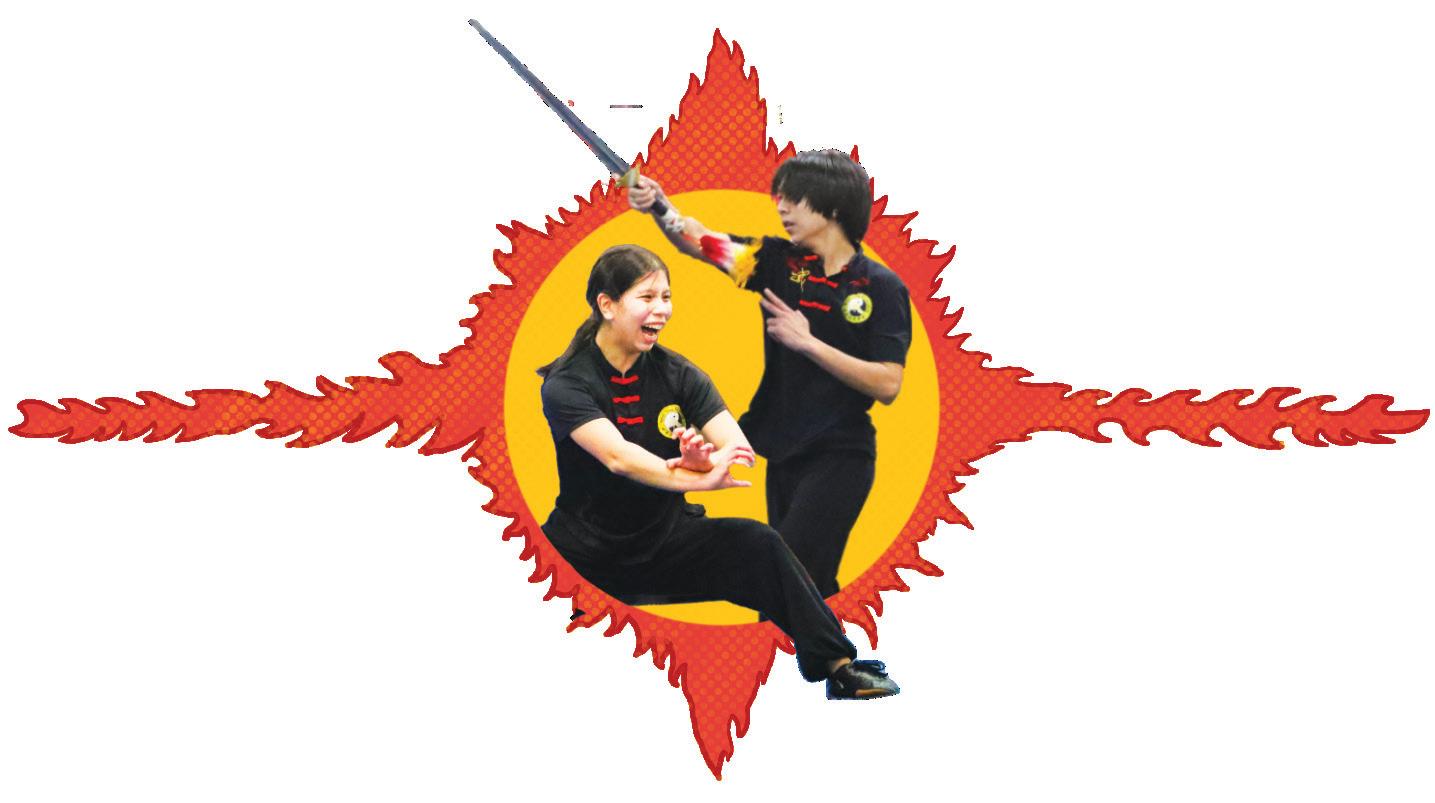

Even the pandemic did not stop them. When competitions like the 2022 Golden State International Wushu Championships were moved to an online format, Chloé and Kai competed, winning gold in their respective categories.
“It’s actually pretty fun,” Kai said. “We’re just hoping to do better than the competition. That’s all.”
As the overseas COVID-19 traveling regulations loosen, Chongfang hopes to bring his students to competitions in China to help them gain new experiences and broaden their perspectives.
“Even if we don’t win, it is still important for my students just to see what’s outside of our own bubble here in Sacramento.”
Aside from competition, Chloé and Kai have connected with Chinese tradition through performing with the Honor Kung Fu Academy team at local events celebrating occasions such as the Lunar New Year.
These local events present new challenges, such as having to perform wushu in the cramped environment of a restaurant.
“I have horror stories from performing at restaurants,” Chole said jokingly. “You make stuff up as you go and try not to destroy the area around you or hit people.”
Recently, the siblings also performed at a Sacramento Kings game the Golden 1 Center.
“Apparently, the audience liked it,” Kai said. “The NBA people came in and told us that they wanted us to come back.”
Regardless of the challenges, the Hiraharas don’t plan on stopping wushu anytime soon.
Currently, Chloé is mastering the threesection staff, a weapon she is using for her upcoming performances and competitions.
Chongfang believes Chloé is focused and has an eager-to-learn attitude, but is still working on relaxing her mental approach toward kung fu.
“Chloé’s respect and patience in her approach towards learning shows in the quality of her improvement, but she still has a lot of room for growth in further overcoming her nerves,” Chongfang said. “I know she has a lot of pressure from her responsibilities in school and other activities, but I think helping her open up will speed up her improvement even more.”
Although her time in high school will soon come to a close, she plans to continue wushu even after her graduation.
“I’m planning to apply specifically to the University of California, Los Angeles, because they have a Wushu Team that does international competitions,” Chloé said. “The majority of the colleges I want to apply to have schools around them that teach wushu, so I hope to continue it.”
Kai’s rapid improvement and meticulous mastery of skills have made him an advanced performer and a knowledgeable teacher’s assistant at the Honor Kung Fu Academy.
This year, he hopes to audition for the national wushu team, to take his craft to a higher standard and perform on the international stage.
“The care Kai puts into both helping me explain concepts to other students and in his own training has helped him improve greatly in such a short amount of time. He sets a high standard for himself and is very well-adjusted at the moment,” Chongfang said.
Watching his kids gain an appreciation for their new sport in the last few years has been rewarding for Dr. Hirahara.
“I grew up watching kung fu films all the time, so going to practice is like going to the movies every day,” their father said. “But, I think the thing that’s most gratifying is not watching them do it, but to see their enjoyment of doing it, their satisfaction with their performance and their desire to improve.”
FEATURE 04 FEBRUARY 08, 2023 • THE OCTAGON
STORY AND GRAPHICS BY GARMAN XU * PHOTOS BY ADAM AKINS AND COURTESY OF ALAN HIRAHARA
Starring CHLOÉ HIRAHARA and KAI HIRAHARA
Sanjana Anand, ’22, enters prehealth program at Duke
BY ANIKA NADGAUDA
Sanjana Anand is attending Duke University in Durham, North Carolina, and is majoring in biology with minors in chemistry and global health.
Q: Why did you choose to attend Duke University?
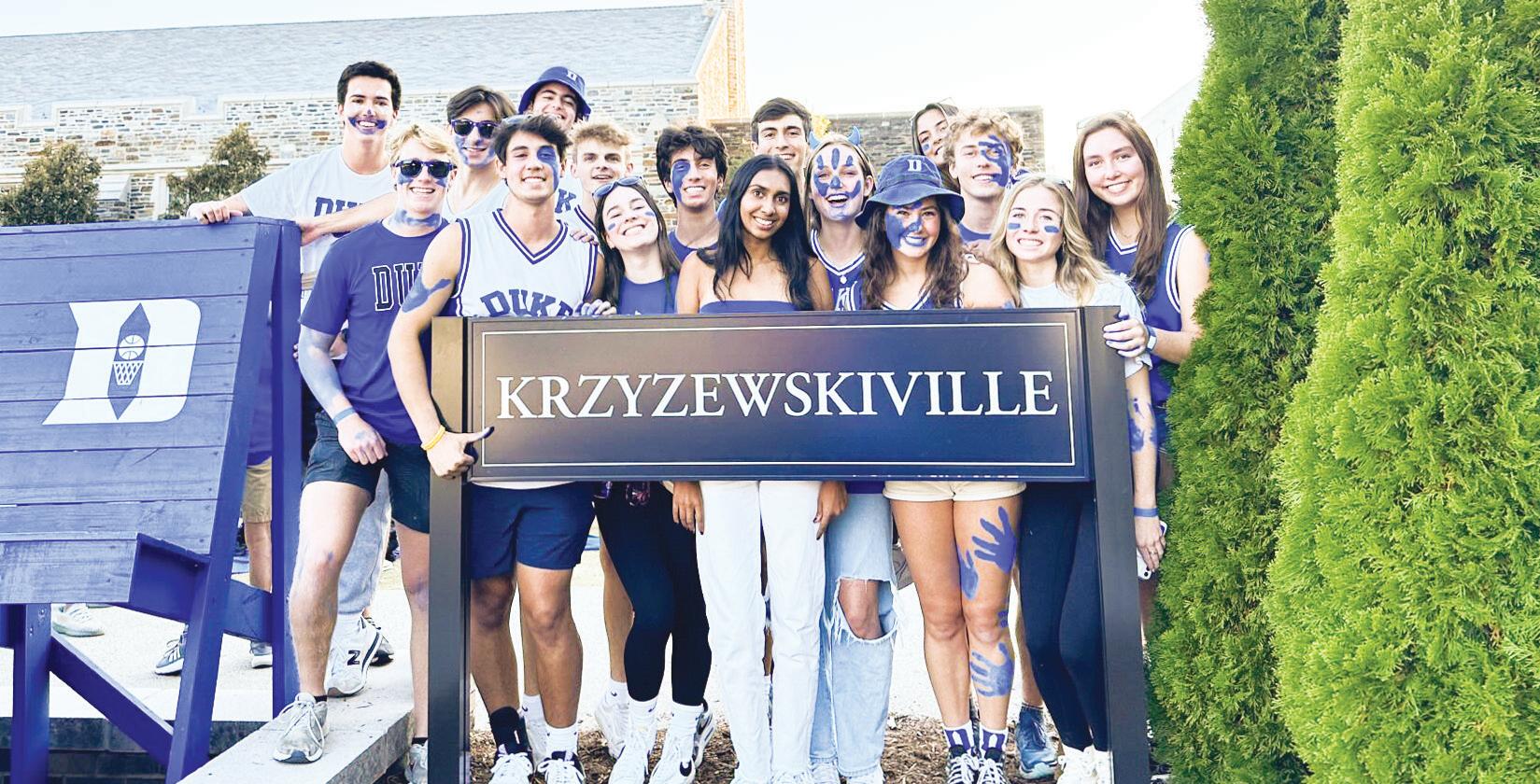
A: I actually applied early decision to Duke, and it was for four reasons.
I think after my experience at Country Day, I wanted a smaller environment where you can make meaningful connections with faculty members as well as students, but not too small where I couldn’t meet new people.
And that’s exactly what Duke is like. I’m meeting new people every day. There are always things to do.
I’m also prehealth, and Duke has an amazing prehealth program because of the hospital and the amount of research funding and everything we’re getting. So, definitely that, and also the student to faculty ratio is surprisingly low.
There’s a lot of opportunity to do whatever you’re interested in and there are so many clubs here that it’s just insane.
Q: How has the adjustment period been?
A: I thought being so far away from home would be a lot, but honestly, I’ve been adjusting pretty well. I’d say it was a little overwhelming at first though. I have not been homesick yet, and I honestly like that. I like this new changing environment because I don’t think I would have moved out to the East Coast unless I had to.
Q: What is your favorite class that you are taking right now?
A: I don’t think I can choose just because all my classes are really different. I’m learning new things in all of them.
Q: What is the size of your smallest class? Your largest?
A: I think it is only about 10 or 12 people. My largest class is a lecture. It is around 100 to 150 people.
Q: What is the biggest difference between those two classes?
A: It’s definitely different because the professor in my smallest class knows my name versus the professor of my larger class probably doesn’t know who I am.
I mean, in the smaller class, you’re participating more, but it’s similar to a seminar versus a lecture. I’m not retaining in-
formation any differently or any better. I’d say it’s just a different style of class.
Q: What is housing for students at Duke like?
A: I have the worst building: the oldest one.
All the freshmen live on East Campus, so the sophomores and juniors live on West Campus, so you have to take a bus there. The East Campus dorms are where all the freshmen can stay.
I think I live in the worst building because it’s the oldest. I think this dorm has been here since around 1920.
In terms of my room itself, I have a corner room on the first floor, so it is very big; we have enough space for a futon.
The bathroom situation is a little weird because we have coed dorms.
Both guys and girls use the common bathroom because our dorm used to be where the first floor was all guys and the second and third floor were all girls. This year, they made all three floors boys and girls, and the bathrooms aren’t updated for that.
We also have mold poisoning in our dorms because the building is so old. I also saw a cockroach yesterday, and I made my neighbor come and kill it.
Duke has this new system, Quad EX, which is where the people living in your dorm and another dorm live together in shared dorms on West campus during sophomore year, so it’s already pre-planned where you’re gonna live.
Q: What are meal plans and cafeterias like on campus?
A: The food here is absolutely amazing. I believe it’s ranked No. 30 as the best college campus dining in the nation by U.S. News & World Report. All the freshmen are on the freshman meal plan; you don’t really have a choice.
On East Campus, we have marketplace, which is our dining hall, and we have breakfast and dinner swipes every day. Every day for breakfast and dinner we will go there and have a buffet with all sorts of options.
For breakfast, we have a station called The Grill. It changes every day, but there’s a variety of French toast and pancakes with hashbrowns and different types of potato. We have Durham market, where all the produce they use is grown locally in Durham.
For dinner, there’s Mexican food, Chinese food and American food. There are a lot of food options.
We have something called Western Union, which is the dining commons. It is on West Campus, which is where you eat
lunch and where all the sophomores and juniors eat, and there’s a combination of 10 restaurants. It includes a zone which is Mediterranean food, Chipotle, and there’s Tandoor, which is Indian food. There’s Il Fornaio, which is pizza, pasta and wings. There’s Ginger and Soy, which is an Asian place. So there’s a ton of burgers, pizza, pasta, fries, things like that.
On top of that, we also have other places to eat on campus, like McDonald’s. There’re tons of cafes and coffee shops as well.
Q: Are you part of any clubs on campus?
A: I’m in Phi Delta Epsilon International Medical Fraternity.
I just got in, so I’m pledging right now, but it’s been really fun. The community is amazing.

It’s a chance to meet people who are in a similar field as you and get advice on majors and what classes to take. Also, it’s helpful for getting prepared for med school. We talk to professionals and people who have already gone through med school. They advise us on how to prepare for the MCAT, what classes to take and things like that.
I’ve met a lot of upperclassmen through that, and we have socials and stuff so it’s great to get to know people.
I’m also in club tennis. Everyone on tennis here is extremely good though, but that’s a good place for me to meet people and play tennis because the courts here are very good.
I’m also the review editor for the Duke Medical Ethics Journal, and every semester we have a theme. This semester the theme is Medicine for Marginalized.
Q: Do you have any advice for the class of 2023?
A: I don’t really have advice, but you have this idea of what college is gonna be like before entering, but I was completely wrong. So I’d say, come in with an open mind and be prepared for anything and everything. Be excited that you’re surrounded by like-minded peers who have worked equally as hard as you to be here.
Just enjoy yourself. It can be really overwhelming at first, but remember that everyone’s always here for you. It’s gonna be an adjustment, but you’ll find people here who you will really like to spend time with, and there’s always something for everyone.
Just remember that, and honestly, take advantage of the college opportunities because there are so many that I never had access to in high school.
FIVE STAR OR SUBPAR?
Quality of classes: School Spirit:
Food:
Social Scene: Clubs: Location: Student-Teacher Interactions:
FEATURE 05 FEBRUARY 8, 2023 • THE OCTAGON
CRAZY KRZYZEWSKIVILLE Sanjana Anand (middle) poses with friends as they get hyped up and ready for the first Duke basketball game of the season. PHOTO COURTESY OF SANJANA ANAND
taking AIm
(continued from page 1)
“There is a system it is trying to engage in, so often you can get horrible responses,” Ryan Pirie said.
Reinforcement learning is the AI type used by ChatGPT.
“If it does something good, it gets a reward similar to a child getting a cookie. Often it’s trying to beat the system that’s been set up, so that’s the reason for faulty information,” Pirie said.
Nevertheless, the system has its benefits.
“If you have a large piece of text and you don’t quite understand it, like if a sixth grader was trying to use it, you can simplify it to a sixth-grade reading level,” Pirie said.
As he continues to work on his AI program, he plans to return to ChatGPT and other similar AI services.
exploring ChatGPT educational uses of AI
One area that ChatGPT has the potential to affect, for better or worse, is academics.


Senior Savanna Karmue has recently started using ChatGPT for her AT Anatomical and Physiology class, which requires her to research various diseases, illnesses and body parts. She uses that to complete her study guide for the course. Karmue describes ChatGPT as an “online doctor” and uses it as a search engine.
Karmue cross-references ChatGPT’s information with online Google searches to gather all the necessary information for her assignments. She then utilizes this information to complete her assignments in her own words.

“It has a lot of information, and it is really able to consolidate all that information into one search, which is really helpful and helps me complete my assignments faster,” she said.
ChatGPT comes with downsides as well.
“Some of it is inaccurate. Obviously, there are limits to AI,” Karmue said.
ChatGPT also crashes regularly as a result of the increase in demand and spike in usage.
Senior Ryan Paul also uses ChatGPT to verify his answers for math and science classes.
When he’s assigned problem sets in Advanced Placement Physics C, the textbook only provides answers for even-numbered questions.
“So, to see if I did it right, I plug in the question into ChatGPT, and it tells me how to do it,” he said.
Computer science teacher Charles Farris, who goes by Mr. Charles, has also been testing ChatGPT’s limits.
“I haven’t used it for anything I’ve been producing, more just been experimenting with it and seeing what answers it gives and data it provides,” he said.
Even asking the same question twice can yield different results, he added.
Charles has high hopes for the AI’s potential. He examined ChatGPT to check out the possibility for beneficial or harmful community building, as well as data interpretation and responses.
“There is a lot of potential for good uses, and evil uses,” Charles said.
Using the service has been both “intriguing” and “inspiring” due to the power of ChatGPT’s data
analysis and production. It is given few instructions before producing a large amount of information.

“I think the potential for good lies in the sheer amount of data it can process and redistribute, so I feel like it gives a really holistic snapshot of the state of the internet,” he said.
However, Charles said that those data-analysis methods could also be used maliciously.
Because ChatGPT reflects the internet, it can also reflect various prejudices contained in its data set, from sexism to racism to homophobia.
Ultimately, Charles said ChatGPT’s net effect on society lies with those who use it.
“If you are reading this and find yourself using ChatGPT, I hope that you find a way to use it for good,” he said.
tions that pushed Paul to include more nuance within his thesis.
However, ChatGPT is “below mediocre” when it comes to writing longer pieces, he said.
“It’s definitely not the writing that I’m used to writing, and I don’t think it’s the level I’m at or anyone else in our class.”
ing, that might make me suspicious.”
Bauman is considering altering her curriculum by having students write by hand more often to establish a baseline for their personal voice and style.
It’s especially useful when Paul is unsure of how to complete the question, he said.
ChatGPT also provides an explanation of how it reaches its solution so that Paul can use its response as a starting point.
However, it’s far from a flawless experience.
The AI frequently makes mistakes, he said. On one AP Physics C multiple-choice question he had to disregard ChatGPT entirely.
“I was doing this question on momentum, and I was a little confused on how to do it, so I plugged it into ChatGPT,” he said. “It gave me an answer but the answer there was not an answer choice on the worksheet.”
He had to correct the AI by informing the AI of its mistake and finally received the correct answer after several iterations.
Paul also uses ChatGPT to assist with English writing, but has run into the same limitations of the AI’s knowledge.

“I found it particularly helpful with understanding where I need to improve my thesis,” he said.

For a recent Advanced Topics English Literature essay, he fed the AI a first draft of his thesis.
“My thesis was about struggle, so originally, I just wrote ‘the struggle of people,’ or ‘the struggle,’” he said.
“ChatGPT was like, ‘that’s good, but it needs to be better.’”
The AI suggested he discuss the struggle of people in relation to their history, or their struggle to find identity, sugges-
Due to these drawbacks, Paul plans to only use ChatGPT for limited, specific situations.
“You can definitely not rely on it fully,” he said. “You always need to be a little worried.”
English teacher Jane Bauman expresses her conflicting opinion regarding students’ usage of AI platforms for academic use.
Bauman recently read a Dec. 6, 2022 article in The Atlantic about the emergence of ChatGPT, which changed her perspective on the service.
“I felt the Earth shift underneath me that day,” she said.
“It made me question everything I teach, and the value of what we do. But then I thought about it for a while and realized that it, in fact, makes what we do more valuable.”
Bauman feels that by learning to read, think critically and write, a person can analyze what is written in ChatGPT and see flaws in the reasoning and “the flat character of the writing.”
“So actually, it is going to help give us new reasons for insisting that critical reading, writing and thinking skills are super important,” Bauman said.
Bauman has not encountered any students using ChatGPT, as there are distinctive errors that students tend to make in their writing.
“One of the strong points of Country Day’s English department is that students develop a strong personal voice in their writing,” she said. “So if I don’t see somebody’s personal voice in their writ-
In addition to ChatGPT’s lack of originality, imagination and voice, the service also poses a significant misinformation risk.
“Another reason students have to learn to use their critical
CENTERPOINT 06 FEBRUARY 8, 2023
academic dishonesty at ChatGPT
The most glaring concern relating to ChatGPT is the risk of academic dishonesty.
English teacher Jason Hinojosa has “mixed feelings” about ChatGPT’s use.
“The clutching of the pearls right now in the English teacher community is about cheating, and that concerns me somewhat, but I feel like it’s just the latest fashion of cheating,” he said.
Although ChatGPT provides a sophisticated, easy way to plagiarize assignments, Hinojosa said the burden of academic dishonesty falls upon the student.
One such student, a sophomore who requested anonymity, has used the AI service on “busy work,” finding the convenience and time-saving aspect of ChatGPT was too powerful not to ignore.
“You feel guilty using it but at the same time it’s stupid not to,” the sophomore said.
“You just type a sentence and you don’t have to do anything except wait for 10 seconds. Otherwise, it would take you half an hour.”
The sophomore has used ChatGPT for a variety of tasks, primarily busy work from human geography and the sophomore project.

For the paper portion of the sophomore project, students need to complete notecards paraphrasing quotations relevant to their research.
“Normally, it would take me 10 minutes per notecard,” the sophomore said. “It was near the end, so I was a little behind, and I needed to get the notecards done. I used ChatGPT and it took less than a minute.”
So far, these AI-written submissions have gone undetected.
“I’ve gotten A’s on everything,” the sophomore said. “I’ve actually not even got a single point docked off because teachers
can’t know if you’re using ChatGPT or not.”
However, AI relies on specific input. In order to generate an output, a user must type in a prompt. While ChatGPT is generally strong in generating summaries, the sophomore said, finding specific details can be more difficult.
Often, it requires asking follow-up questions and rating the answers generated.
A senior who also requested anonymity used ChatGPT on an extra credit assignment.
“Everything was on topic. Everything could be passable for a human, and that’s interesting,” the senior said.
While the potential of the AI is clear, the anonymous senior does not plan to use ChatGPT again, saying it would be “a bridge too far” to hand in an AI-written essay.
“Especially in a small environment like Country Day, teachers become acquainted
with your voice as a writer,” the senior said.
“It still is clear that a human isn’t writing it,” the senior said. “It’s not the old collection of buzzwords that AIs would spit out, but still clearly not a student’s voice. It’s too polished.”
While there are ways to detect ChatGPT’s influence on a written assignment, it is a subjective judgment.
Hinojosa is unsure about his ability to detect artificially-generated text.
“I think my detectors are pretty good, and there are certain grammatical tells,” he said. “Occasionally, there will be a cognitive stutter-step in what I’ve read.”
Even so, he said he would not be surprised if an AI piece slipped by him.
Despite the new risks, Hinojosa does not plan to make significant changes to his curriculum. While small fixes, such as implementing more hand-written work, might solve the immediate problem, he said cheating is a perennial issue.
“I’ve caught a number of students cheating in the past. I’m sure many more than I’ve caught have gotten away with it, and I think I have to make peace with that,” he said.
“As an educator, it breaks my heart a bit, because I love what I teach, and I hope my students will engage with it, but there’s only so much that can be done without driving yourself mad.”
CENTERPOINT 07 THE OCTAGON
Community service must be a priority
Think Critically. Live Creatively. Act Compassionately. That is the core mission statement of Sacramento Country Day School, and for the most part, the administration and students uphold it. However, we must improve on one front: service for the greater Sacramento community.
As it stands, Country Day requires high schoolers to complete a certain number of community service hours to graduate.
Traditionally, that number has been 50; however, with the outbreak of COVID-19 and the subsequent period of quarantine, that number was modified for impacted classes.
Now, the current sophomores must complete 37.5 hours, the current juniors 25 and the current seniors only 12.5. For the freshmen class, the requirement is back to 50.
Now, these numbers themselves are not necessarily the problem. Although the 50-hour requirement is less than half of Cristo Rey High School’s 115 hours and Sacramento Waldorf School’s 120 hours, the requirement is ultimately just a minimum. If students choose, they may far exceed it.
Thus, it is not the requirement itself that warrants concern, but the general lack of discussion surrounding community service, something some attribute to the pandemic.
“When I was a freshman, I remember there were these upperclassmen that led these great nonprofit and community clubs which the school really supported,” senior Savanna Karmue said.
Karmue is referring to alumni Bri Davies, ’21, and her nonprofit, Generation Great, formed for the purpose of tutoring underserved students.
“At the time, her club was really active within the Country Day community, and the school really put a great emphasis on it. So, I thought the school had a great focus on community service,” Karmue said. “But, as soon as we got to COVID-19, it died down. I did not see nearly the same aspect and emphasis the school brought before COVID-19.”
Today, Country Day offers high schoolers the opportunity to join a community service elective where they can volunteer in-house every other day for an hour. That elective and annual fundraisers like the Play-a-thon and Run to Feed the Hungry account for the majority of community service opportunities at Country Day.
But, that should not be the case.
Community service is far too important to be neglected. Students should be regularly supporting the greater Sacramento community.
According to research conducted by the Corporation for National and Community Service, students who engage in community service regularly gain a deeper understanding of local issues, develop a stronger sense of civic duty and have a sense of purpose and direction that proves beneficial as they navigate the challenges of high school and beyond.
Specifically, community service allows high school students and young adults to explore their passions and interests, while making a positive impact on their communities.
On top of that, that same CNCS study found community service can improve students’ academic and career prospects. The study revealed that students who volunteer have shown to achieve dramatically higher grades, test scores and graduation rates, along with a 27% boost of finding jobs compared to students who do not.
Not to mention, community service does more to a students’ physical and mental health than most would think.
In a research study published in the Journal of Adolescent Health, it was empirically revealed that participation in community service was linked to a decrease in depression rates, an increase in overall satisfaction with life and an improved physical well-being.
Aside from benefits reaped by the volunteer, volunteering betters the greater community by providing valuable labor.
In fact, a joint study by Independent Sector, a coalition of nonprofits, foundations and corporations, and the Do Good Institute estimated that the average value of one volunteer hour in America in 2021 was $29.95. In California, it was $35.56.
Of course, a dollar amount cannot indicate the true value of volunteer work, but it does begin to quantify just how valuable volunteers are, particularly for nonprofits and agencies that serve the disadvantaged populations.
For the individuals impacted, just having someone care about them can make a world of difference.
Volunteer work is a must, and to some degree, Country Day realizes that.
Prior to the pandemic, Country Day established a fiveyear plan that began in 2018.
“In the second pillar, the first goal was to implement a campus wide service learning program that contributed to the greater good of local and global communities and provided students opportunities to build life skills,” Head of School Lee Thomsen said, paraphrasing the report.
To begin this process, the school established a com-
mittee to create a proposal. With the COVID-19 outbreak, that committee’s plans were postponed.
“At some point, I would love to have a service learning program at Country Day,” Thomsen said.
Service learning differs from traditional community service requirements in that it encourages students to both engage and reflect as part of their curriculum.
At Country Day, Thomsen said he envisions a service learning program that begins in the lower school, but would require the school to hire a specialist to oversee the program.
With other programs like the Academic Resource Center requiring more immediate support, the plan to create a service learning program has fallen down on the list of priorities.
However, there are still ways for the school, at the very least the high school, to further encourage community service.
For starters, the school can modify the Sophomore Project to include a volunteer component.
Traditionally, the project requires sophomores to select a topic related to the Sacramento area that they will then research. At the end of the research process, they write a paper and then present their findings.
Moving forward, the school should consider requiring students to also engage directly with the material via volunteering.
For instance, a student researching advancements in medicine might volunteer with the Ronald McDonald House. A student researching food insecurity might volunteer with the Sacramento Food Bank.

Whatever it may be, students would undoubtedly receive a greater understanding by engaging directly with the subject matter.
Additionally, the high school can further encourage involvement with the greater Sacramento area by adding an amendment to the current community service requirement.
Rather than allowing students to complete all their hours at Country Day or over a short period of time, the administration should enforce a yearly quota of hours to be completed with an organization outside of the school.
If students are volunteering regularly, at the very least annually, community service the entire school will see the service as an ongoing commitment rather than a one-time requirement.
As discussions about next year begin, both students and the school should consider placing additional emphasis on community service. Only then can we truly think critically, live creatively and act compassionately.
EDITORIAL:
08 OPINION FEBRUARY 8, 2023 • THE OCTAGON
“In our own bubble ” by Brynne Barnard-Bahn
MY ANGLE: Ronaldo is the true GOAT of soccer
BY ANDREW BURR
Whether you are a die-hard soccer fan or just stick to watching the World Cup, you likely know two names: Lionel Messi and Cristiano Ronaldo. These two men are widely considered the greatest soccer players ever. For years, however, fans have been in a fiery debate about which player is the Greatest of All Time, or GOAT.
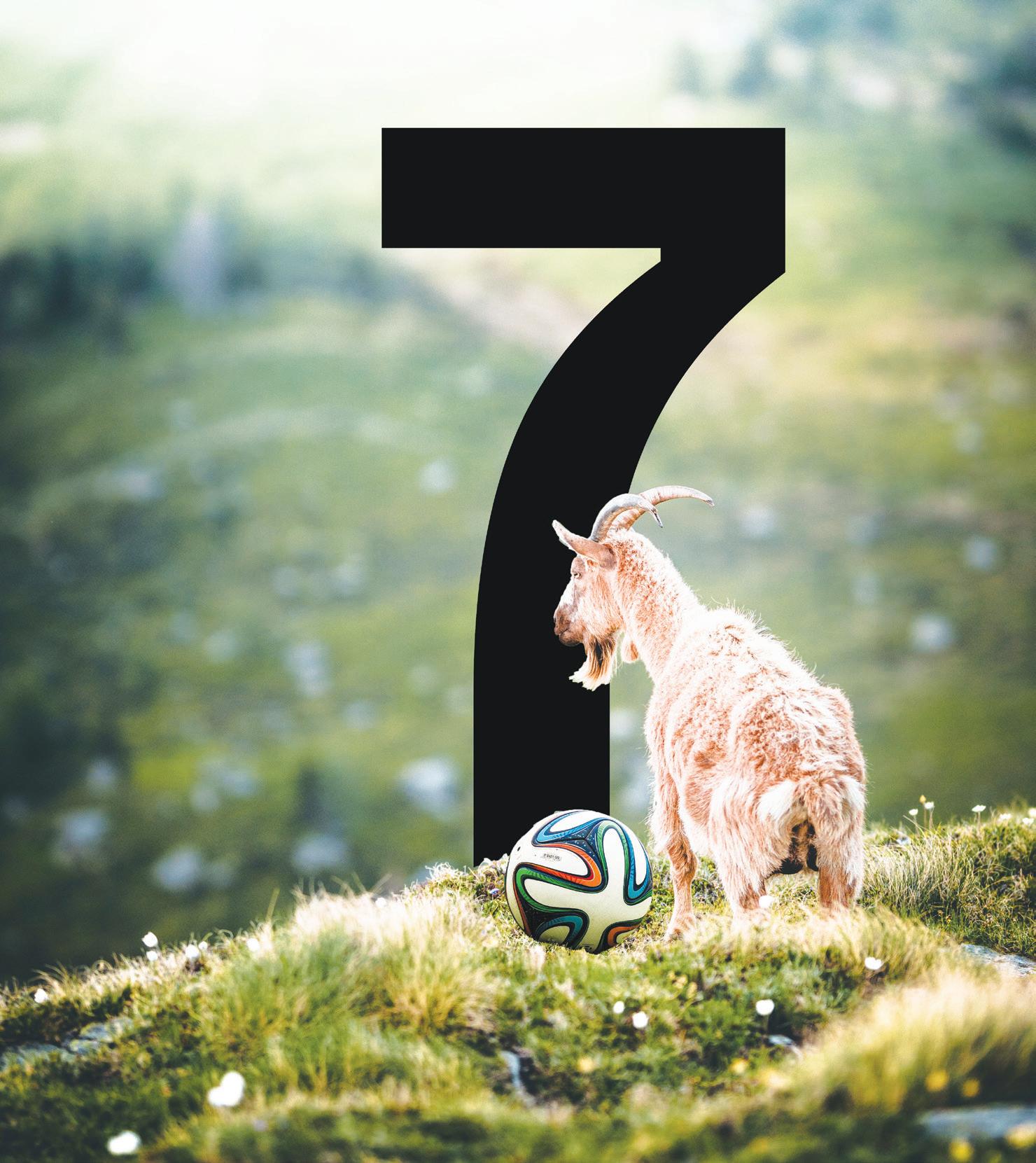
Despite many fans on both sides of the table providing arguments for each player, there has only ever been one correct answer when comparing them head-to-head; Ronaldo.
This debate intensified and became more one-sided after Ronaldo’s controversial move to the relatively small Saudi Arabian club AlNassr and Messi’s 2022 World Cup win.
In general, fans were angry about the AlNassr move because the club didn’t have much history, the league wasn’t especially competitive and money was the primary incentive for Ronaldo.
According to NBC Sports, this year, Ronaldo will officially be the highest-paid sportsperson in history, with a new contract earning him over $200 million, just adding yet another superlative that can be used when describing him.
The biggest issue I have noticed regarding the GOAT debate is a large group of bandwagon fans who support both Lionel Messi and Argentina because of their World Cup campaign and the abundance of related mainstream press.
A large proportion of these people are not true fans of the sport and seldom watch matches outside of the World Cup every four years. This becomes obvious scrolling through social media, seeing people with little to no history with the game posting photos of Messi and calling him the GOAT.
Sure, if you only consider World Cup goals, Messi comes out on top with a tally of 13. Despite this, Ronaldo has scored in all five editions of the World Cup he has played in, making him the first male player in history to do so.
On top of that, at 37 years old, Ronaldo’s penalty goal against Ghana in the round of 16 made him the third oldest player to ever score in a World Cup match.
Although his World Cup performances have been very impressive, Ronaldo’s overall career achievements are what make him shine.
According to Sporting News, Ronaldo is the top professional goal scorer of all time, with 819 goals across 1,144 games. Over two-thirds of these games have been in La Liga and the Premier League — the two most competitive leagues in the world.
Ronaldo led Portugal to the country’s firstever win in the Euros against a majority of the world’s most competitive national teams. Comparing this to Messi’s Copa America wins against teams for the Americas is almost laughable, considering the gulf in quality between the two tournaments.
Ronaldo has won the second most Ballon d’Or awards in history and has won more European Golden Shoe awards and Ballon d’Or than any European player in history.
In the UEFA Champions League, Ronaldo has earned the nickname “Mr. UCL” by, leading his team to victory once with Manchester United and four times with Real Madrid.
Although Messi has the most Ballon d’Or awards at seven, it is widely considered that Ronaldo’s sixth was “stolen” in 2018 because of a heavy focus on Luka Modric’s World Cup performance.
Cristiano Ronaldo can genuinely be considered the most outstanding all-around athlete to ever step on a soccer pitch.
According to the official Olympics website, Ronaldo holds the record for the highest header in-game at a staggering 2.93 meters.
Stats aside, Ronaldo’s work ethic is one of, if not his most admirable qualities.
Being two years older than Messi, Ronaldo has had to work harder than Messi to maintain the same level of play for years. Ronaldo looks even fitter today than he did 15 years ago, and this doesn’t seem to be changing any time soon.
Ronaldo pushes himself beyond the challenges and adversity he faces, such as
mistreatment at clubs, the loss of his child and an overwhelming amount of hate online and in person.
His unrelenting work ethic, no matter what happens, is the thing that truly separates him from his competitors.
With the looming retirement of Messi and Ronaldo on the horizon, this leaves one
question for all soccer fans: will there ever be another player on the same level as Messi and Ronaldo?
Either way, there is a limited time left to watch them play. Whether your opinion on the GOAT debate is right (Ronaldo) or wrong (Messi), now is the prime time to enjoy and celebrate their careers.
ADVICE: Problems and perils of prohibited love
BY ANONYMOUS
This is an advice column that responds to questions from anonymous Country Day students. To submit, send a question to the Google form sent out on Nov. 30. Responses are not guaranteed, but all submissions are welcome.
Q: I really like this boy, and he likes me too, but we cannot be in a relationship. I can’t move on. What do I do? Should I continue being friends with him?
Your situation is definitely unique. Rather than being faced with an unrequited love, you are simply incapable of furthering reciprocated feelings into anything concrete. So, in your case, you have a few options.
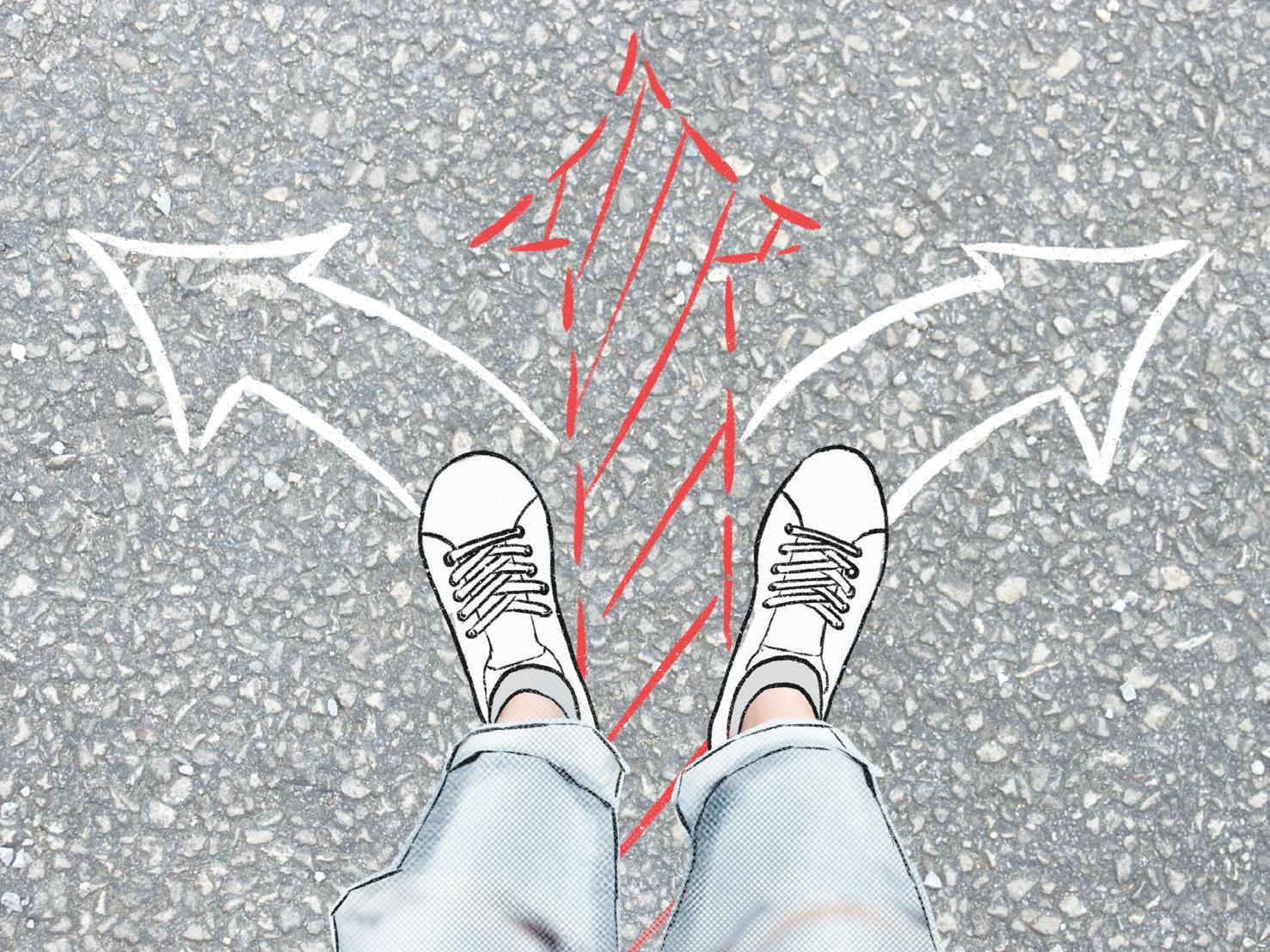
Of course, you can be in a pseudo-relationship. Effectively, this would entail couple-like behavior without an official label. With this approach, you two can remain close friends and even close confidants, you just can’t progress any further.
Now, I give you this option, but I don’t necessarily suggest it. By having a relationship with no label, one of you is bound to be
hurt. When one person inevitably becomes disinterested, the friendship will crumble because in reality, it was not a friendship but a relationship.
So, as much as it hurts to say, sometimes distance is the only way to find peace. If you cannot date, moving on is realistically the best option.
And yes, I know that is easier said than done. How can a person just move on?
Well, you need space.
If you are interested in someone, you will find yourself frequently thinking about him. The more you think about him, the more you will like him, the more you will want to engage with him and the more you will think about him. This cycle will continue unless you actively break it.
To break it, I suggest you stop spending as much time with him. Distract yourself with friends and activities until you no longer find your mind wandering to that special person.
Once you have moved on, you can start spending time with him again because at that point, the cycle is broken.
That said, if you care about this person, don’t just drop him out of the blue. Have a conversation first. Tell him that you like him and know that you cannot be in a relationship, and thus, you think it is best you guys take a bit of space until you can comfortably just be friends.
Hopefully, he will understand.
Q: I notice that I fall for people really quickly and intensely, but then when things are over, I move on really quickly. How do I stop myself from continuing this cycle?
It seems that you are attracted to the idea of a relationship. You fall for people quickly because you love the idea of being
with someone, and you move on quickly because you never really liked the people but the ideas of what you two could become.
For you, interrupting this cycle will require some internal reflection. I encourage you to ask yourself why it is that you want a relationship so badly.
Now, I don’t know what your reason is, but for many people, a relationship is believed to fill some sort of void. They think that someone else liking them will make up for them not liking themselves.
If you think this might apply to you, you need to take some time to be single.
Spend time with friends or go out by yourself. Redirect your thoughts toward an meaningful hobby or activity.
Either way, you need to enjoy living without some sort of romantic interest. Once you can comfortably be alone, you will likely stop falling for people left and right.
Until you get to that point, I challenge you to do something. When you feel yourself becoming interested in someone, take a moment to consider which of their attributes attract you to them. Are they funny? Are they smart?
If you find that their most appealing attribute is that they are attractive or single, you need to realize that, once again, you are just pursuing a relationship, not a person.
Lastly, I want to leave you with one final piece of advice.
If you are physically attracted to someone, make a conscious effort not to create some sort of romanticized identity for them.
Oftentimes, our minds have a tendency to look for reasons to like people. If you do not want to keep falling for people unnecessarily, you will need to be alert to this tendency, so that it may not overcome you.
OPINION 09 FEBRUARY 8, 2023 • THE OCTAGON
CRISTIANO GOATNALDO After years of outstanding performances, Cristiano Ronaldo has solidifed himself as the GOAT. PHOTO ILLUSTRATION BY ANDREW BURR
“Down the Road” by Garman Xu
Brynne Barnard-Bahn pursues artistic passions
BY AVA EBERHART
The margins of nearly every piece of paper in senior Brynne Barnard-Bahn’s school binders are filled with art.
In her AP Art History class, many of her pages contain pencil doodles that correspond to what is being discussed in class.
On one page, she drew a characterized version of a hieroglyphic figure carved into the Narmer Palette of 31st century BC.
Ever since Barnard-Bahn could use a pencil, she has had a fervent interest in art. She always asked for crayons at restaurants to draw on kid’s menus and borrowed her mom’s pen during musical performances to create artwork on any paper she could find.
“In any situation that was boring to me, I would find a way to draw,” she said.
Barnard-Bahn started taking art more seriously in middle school and began practicing a lot more.
“It’s really therapeutic. It’s just cool to be able to create things, and there’s a lot you can do with art,” she said.
Barnard-Bahn’s art style is generally consistent, comparable to the style of Arcane, a Netflix original show.
“It’s a bit stylized; I don’t do photo realism,” she said. “It’s more realistic than anime, for example.”
In other words, Barnard-Bahn’s main art style is semi-realism.
Over the years, Barnard-Bahn has taken inspiration from various artists that she has discovered on Instagram and other social media platforms.
“Eventually, that led to my own art style,” she said. “It doesn’t look like their art, but you can see the influence.”
Art teacher Andy Cunningham, who has guided Barnard-Bahn since she was in middle school, considers her to be an exceptional student.
“She’s very good at what she does. She works very hard on getting better and learning how to do specific things,” he said.
One of those things is wash drawing, a style of art in which a thin layer of paint
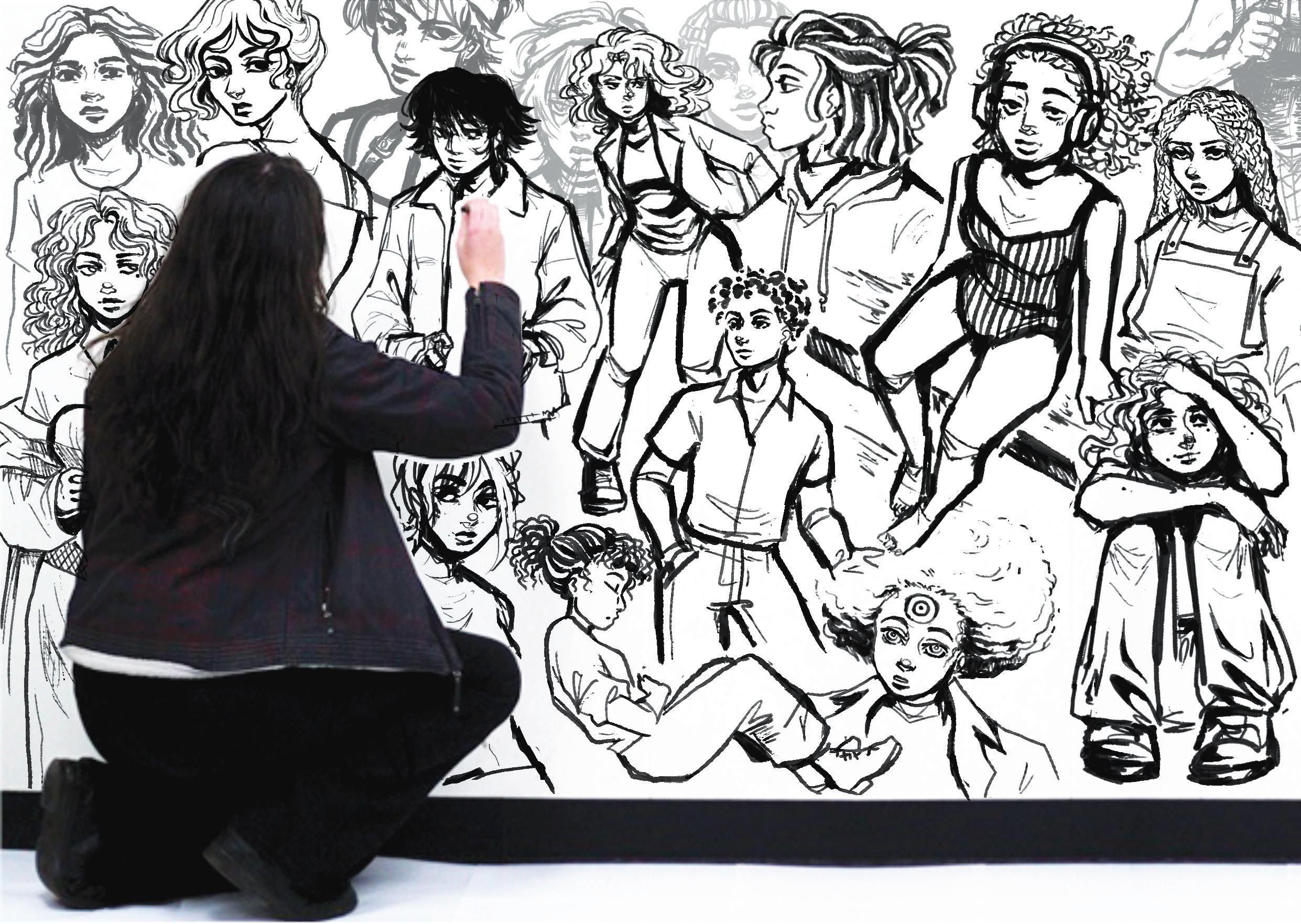
mixed with water is spread onto a canvas, resulting in a smooth layer that lacks visible brush strokes.
“I think those are awesome, and I just like her spontaneous creations,” Cunningham said. “She likes to stay with the monochromatic washes.”
One of her washes is on a large piece of paper, which is displayed in the art room. The painting is based on a photo of two people doing the Lindy Hop, which is a dance style born in Harlem, New York, in 1928.
“She’s never worked with that size ever. I put the paper up there and she did the male figure in under an hour,” Cunningham said. “It happened that quickly. There was no hesitation.”
As Cunningham sees it, Barnard-Bahn has very little fear of failure in the art realm.
“She’s willing to go through pieces that don’t work and learn from them, which is huge. A big problem that some students have is that their fear of failure will stop them from moving forward, so they don’t learn,” he said. “Brynne has no fear.”
Barnard-Bahn often makes pre-drawings and studies the human body before she begins an actual piece.
“Instead of struggling on a pose that doesn’t feel right, she would put in the hours to get it,” Cunningham said. “She will understand how the body functions in a pose and then draw the pose.”
An award-winning artist with The Octagon, Barnard-Bahn’s art pieces are displayed both regularly in the paper as well as around various buildings at Country Day.
“She’s got stuff in the library, she’s got stuff in offices,” Cunningham said.
In addition to spending her AP Art Studio elective working on art, Barnard-Bahn sometimes spends her lunch time in the art room.
“Clearly, she puts in a lot of time and effort into each of her works of art,” said senior Grace Eberhart, a close friend to Barnard-Bahn.
Even so, Barnard-Bahn struggles to set enough time aside for her art, as she can-
not find enough room to set up her workspace at home.

“I want to get better at painting, and the only limitation is that I only paint at school, which means that I only have an hour,” she said. “That affects my pieces.”
Despite this, Eberhart said that Barnard-Bahn’s pieces still come out exceedingly well.
“I know she has limited time to work on art at school, but I can’t even tell. It looks like she’s spent weeks on some of the pieces that took her a few hours, or even just a single class period,” Eberhart said.
Eberhart often sees the detailed, semi-realistic doodles in Barnard-Bahn’s notes.
“She nonchalantly says they’re just little doodles, and it shocks me every time because they’re such good drawings,” Eberhart said.
While working on her art, Barnard-Bahn almost always listens to music.
“It helps me zone out while I’m working so I get into the zone,” she said. “I think my pieces look better when I’m listening to music.”
Her playlists consist of indie pop, alternative, rock and jazz.
“Sometimes, I specifically pick out a certain song depending on the piece I’m working on, but usually I just put one of my playlists on shuffle,” she said.
One of her art pieces is based off of the song “Space Song” by Beach House, in which she drew a drummer in space. The piece is featured in the Glass Knife.
In addition, her love for jazz inspired her to create a jazz-themed AP portfolio for college admissions.
Barnard-Bahn hopes to learn more about animation as she plans to head off to Wesleyan University next year.
“I’ve tried to do it on my own, but I don’t have very good resources for it,” she said. “Seeing stuff by Pixar and Disney has really inspired me, and it’d be really cool to go into animation or CGI.”
Although Barnard-Bahn does not plan on majoring in animation, she wants to take computer science and art classes, which can both be applied to animation.
“Hopefully she takes a studio class in
college,” Cunningham said. “I think she would easily take on the next level of intellectual challenges in a college situation.”
10 FEATURE FEBRUARY 8, 2023 • THE OCTAGON
PHOTO ILLUSTRATION BY BRYNNE BARNARD-BAHN
Moonbelly Bakery Is it out of this world?
Are you craving that perfect croissant but cannot travel to France to get it? Moonbelly, one of East Sacramento’s newest bakeries, is the perfect destination for all of your pastry needs.


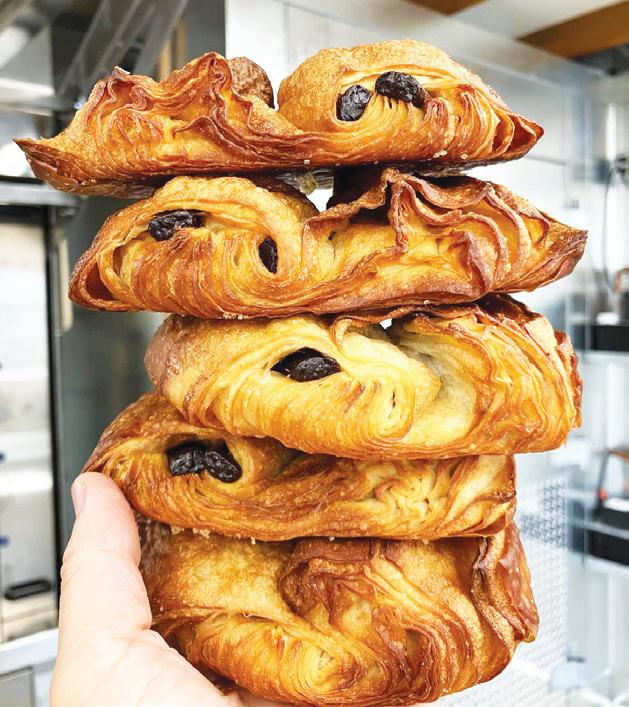
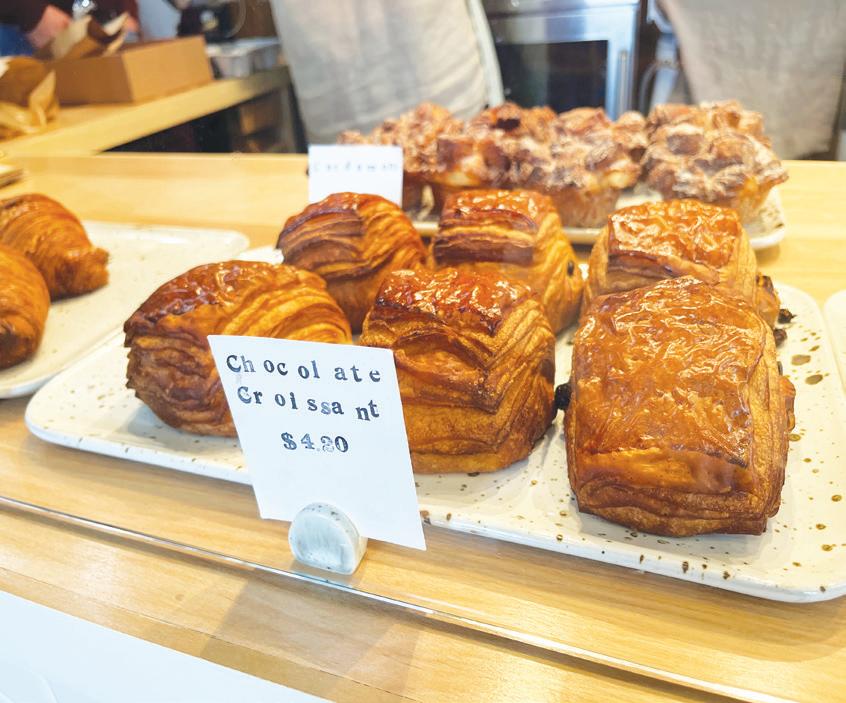
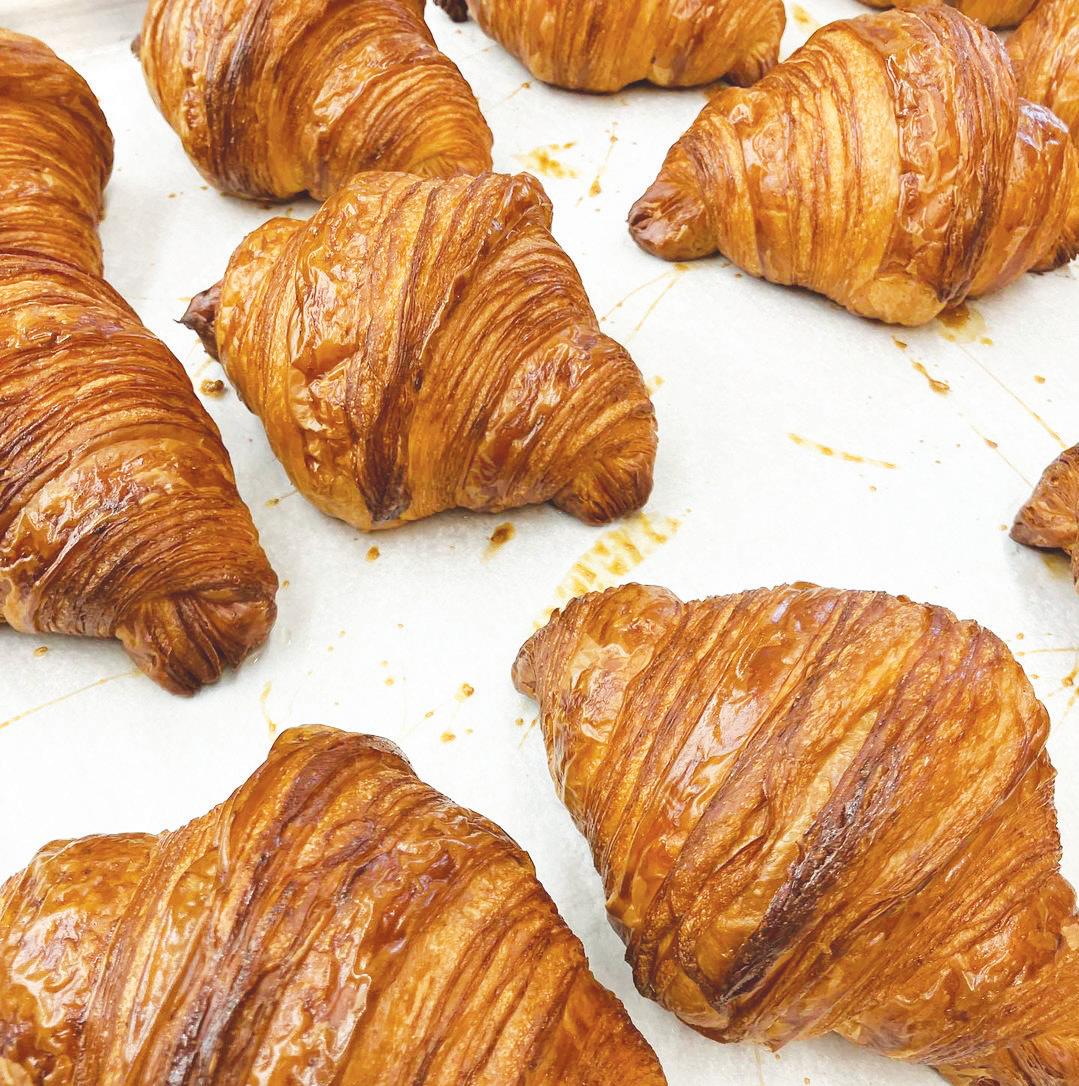
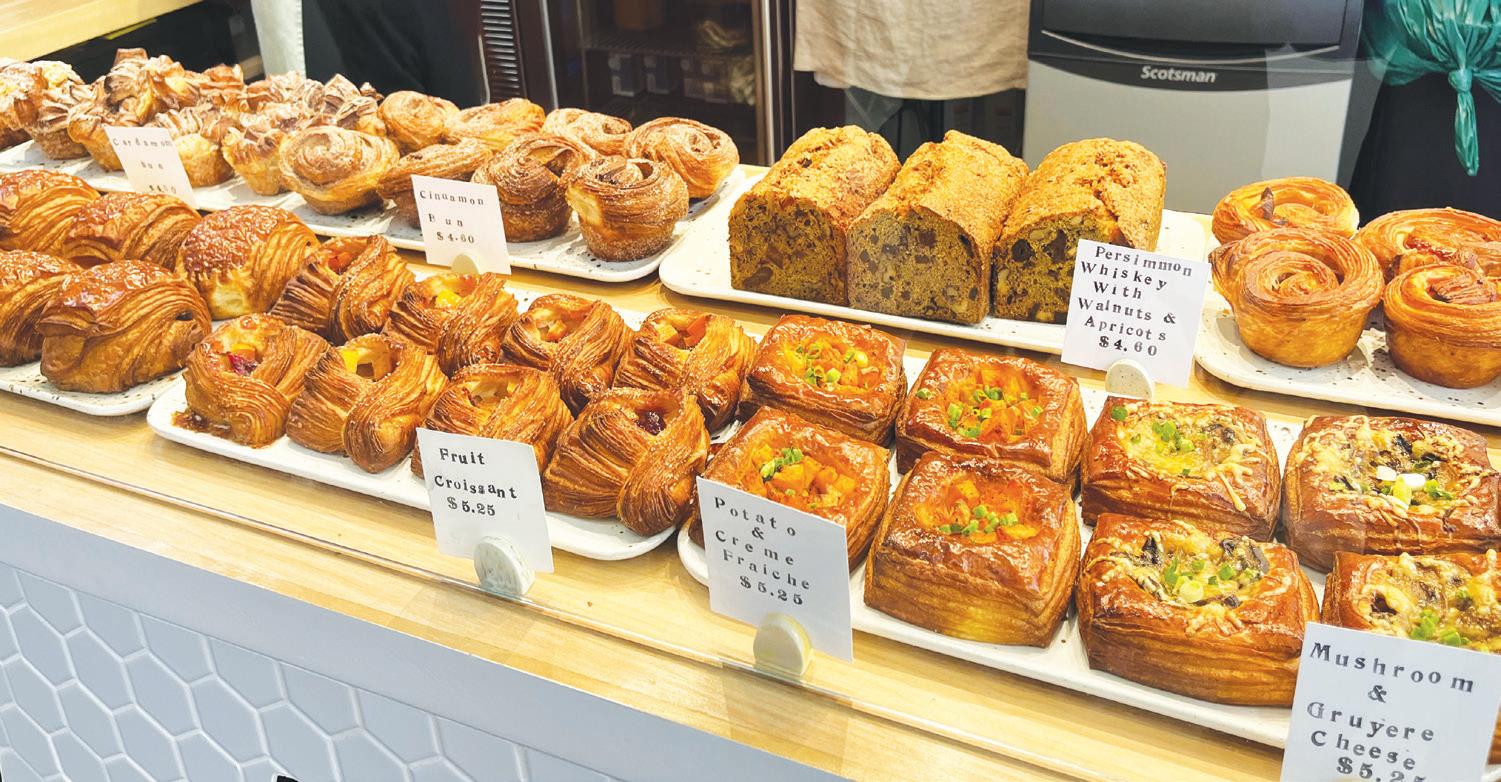
Located at 6511 Folsom Blvd., owner Lucía Plumb-Reyes’ neighborhood bakery is open Friday-Sunday from 8 a.m. to 1 p.m.
Despite not offering cakes, Moonbelly boasts a wide array of cookies, pastries and breads, so of course, I had to check it out.
I arrived at 9 a.m. on a rainy Saturday morning, and the line almost ran out the door. There were a few picnic tables outside under an awning, but it was not the ideal place to enjoy your breakfast on a rainy day. Moonbelly did not offer seating inside, so I decided to purchase several items and take them home to try.
In the building, I was met with the aroma of freshly baked bread. The whole kitchen was right behind where the goods were being sold, so while waiting in line you could watch the bakers in action.
When it was my turn to order, the staff was friendly and suggested some items for me to try.
First, the croissants: Moonbelly is famous for its croissants, so I picked three: the traditional ($3.90), the almond ($5.40), and the chocolate ($4.20).
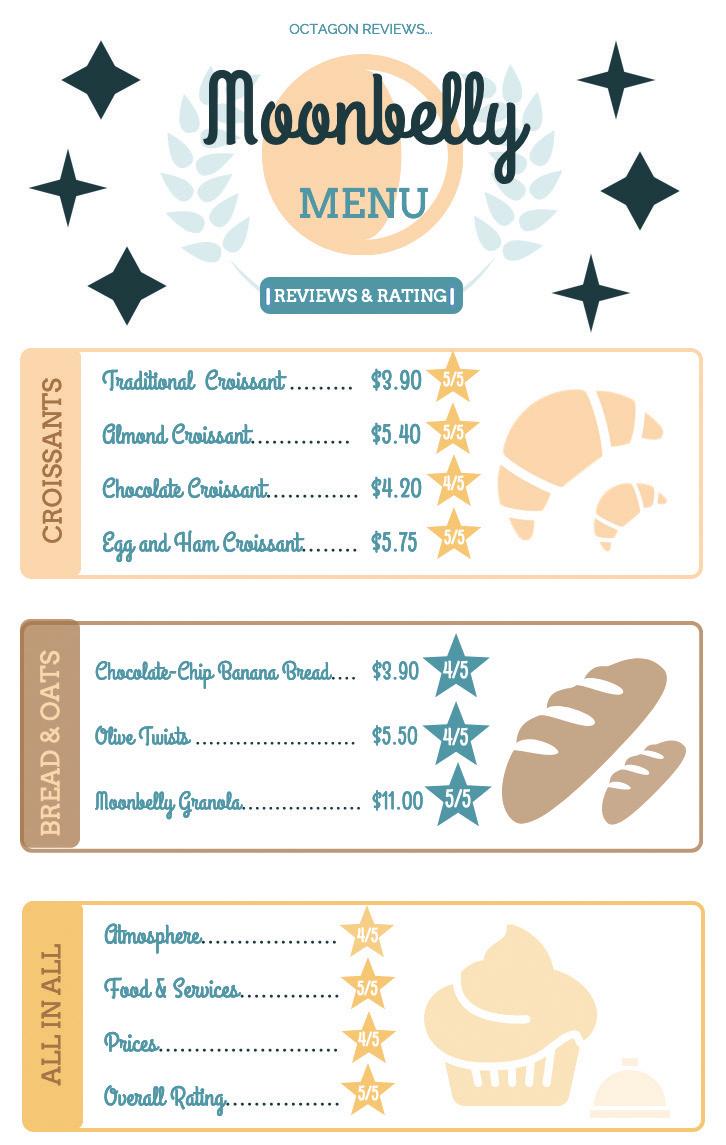
The traditional croissant was arguably the best I’ve ever had. Right as I bit in, the flakes of buttery crust broke off and melted in my mouth. It would pair perfectly with a hot cup of coffee.
The almond croissant, another top contender, was filled with a light paste of crushed almonds. The filling was sweet, and the powdered sugar on top only added to that sweetness, but somehow, the sweetness of the croissant as a whole remained fairly subtle. Along with the sweeter taste, this croissant had a soft breaWd-like texture which the other croissants did not have.
The chocolate croissant was just as flaky and airy as the two before it. With every bite of the croissant’s many thin layers, I was left in awe of the bakers’ mastery. In my opinion, the chocolate croissant had the perfect amount of chocolate, but my brother, an avid chocolate fan, disagreed.
“There’s not enough chocolate and I wish it was more evenly distributed throughout the croissant,” he said.
Maybe the chocolate croissant would not be a chocolate lover’s favorite, but that is where the chocolate chip banana bread ($3.90) comes into play.
Served as a slice, it was perfectly moist and loaded with chocolate chips in every bite. The numerous dark chocolate chips created a dense texture giving a rich flavor.
Along with the traditional, sweet pastries, I tried some of the savory items: specifically, the olive twists (3 for $5.50) and the egg and ham croissant ($5.75).
The olive twists were small baguette-shaped loaves with kalamata olives baked into them. The salty olives complemented the bread, making the overall taste balanced. They were crispy on the outside, soft on the inside, and just the right consistency. If you prefer salty pastries over sweet, this bread is for you.
The egg and ham croissants, another customer favorite, were just as delicious. The flaky croissant dough was wrapped around a piece of ham with a perfectly cooked egg in the middle.
Considering how long it sat before we got home, I was surprised the yolk was still runny. It was hearty but not too heavy, making the perfect savory breakfast.
Lastly, I tried Moonbelly’s granola ($11), which was packed with walnuts and pecans. Though it had maple syrup in it, the granola was not overly sweet, and I was pleasantly surprised to find it had a nice buttery taste. The granola was void of clusters, which in my family’s opinion is the perfect texture for granola.
Finally, even though they were very busy when I was there, the staff was incredibly friendly and helpful. I never felt rushed or pressured to make my selections, and the staff’s promptness allowed the line to flow smoothly and quickly. At checkout, they were kind enough to offer samples of their seed bread and homemade chips, which I did not try.
Upon reflection, the cost of Moonbelly is a bit high, but for the quality of the products, it is worth it. I would recommend it to anyone craving a perfect croissant.
SOPHIA MONASA;

A&E 11 FEBRUARY 8, 2023 • THE OCTAGON
REVIEW BY
GRAPHICS BY GARRETT XU; PHOTOS BY SOPHIA MONASA AND COURTESY OF MOONBELLY BAKERY
Haylee Holman
Last year, senior Haylee Holman spent Valentine’s Day with her then-boyfriend.
He came over to her house, and all seemed to be going well, until Holman received some surprising news.
As he was walking out the door, he informed her that he wanted to break up.
“It was just completely out of the blue,” she said.
Priya Chand
Sophomore Priya Chand spent last Feb. 14 in the park with some friends, but she was not celebrating Valentine’s Day; she was having a Galentine’s Day.
A Galentine’s Day, as it’s called, is a day for girls and women to celebrate their platonic relationships with one another.
For Chand and her friends, this meant having a picnic with some of their favorite snacks while sitting outside.
“I would definitely do it again,” she said.
Valentine’s Day: a day full of roses, love, chocolate and even sadness. Country Day’s students and faculty share their memories from their days of love, both good and bad.
BY ANIKA NADGAUDA; GRAPHICS BY AVA EBERHART
Mia Crowder
STORY
Valentine’s Day is nothing special to junior Mia Crowder. Usually, Crowder spends the day with her friends.
However, there is one Valentine’s Day that Crowder will never forget.
A couple of years ago, somebody asked Crowder to be his Valentine. Happily, she accepted, but to her dismay, he ignored her all day.
“That was the worst Valentine’s Day by far,” Crowder said.












LOVE LOVE AIR AIR
is in the
Christopher Arns
For history teacher Christopher Arns, Valentine’s Day is about Congenital Heart Disease Awareness Week, which takes place from Feb. 7 to Feb. 14.
Arns’ daughter had a risky heart surgery when she was four months old. She was able to recover, and Arns’ family is very grateful for that.
“Just in general, Valentine’s Day, for us, and the few days before it, is always an opportunity in our family to celebrate that she is still here with us,” Arns said.
Jason Hinojosa
One year after English teacher Jason Hinojosa married his wife, he asked if she wanted to do anything special.
After she responded ‘no,’ he prepared a simple dinner of cauliflower steak. Turns out, his wife was expecting more.
“She did not like that, and she has never let me forget,” Hinojosa said.
Another vivid Valentine’s Day memory Hinojosa has is one from his high school years.
He took his then-girlfriend to a fancy dinner. When they showed up at the restaurant, Hinojosa saw his girlfriend’s ex-boyfriend with his new girlfriend. Hinojosa and his girlfriend quickly left the restaurant. They then went to a McDonalds and ate their food on a golf course.
“It did not start well. It turned out to be kind of nice though,” he said.
12 ENDPOINT FEBRUARY 8, 2023 • THE OCTAGON
 BY SAMHITA KUMAR & EESHA DHAWAN
BY SAMHITA KUMAR & EESHA DHAWAN






































